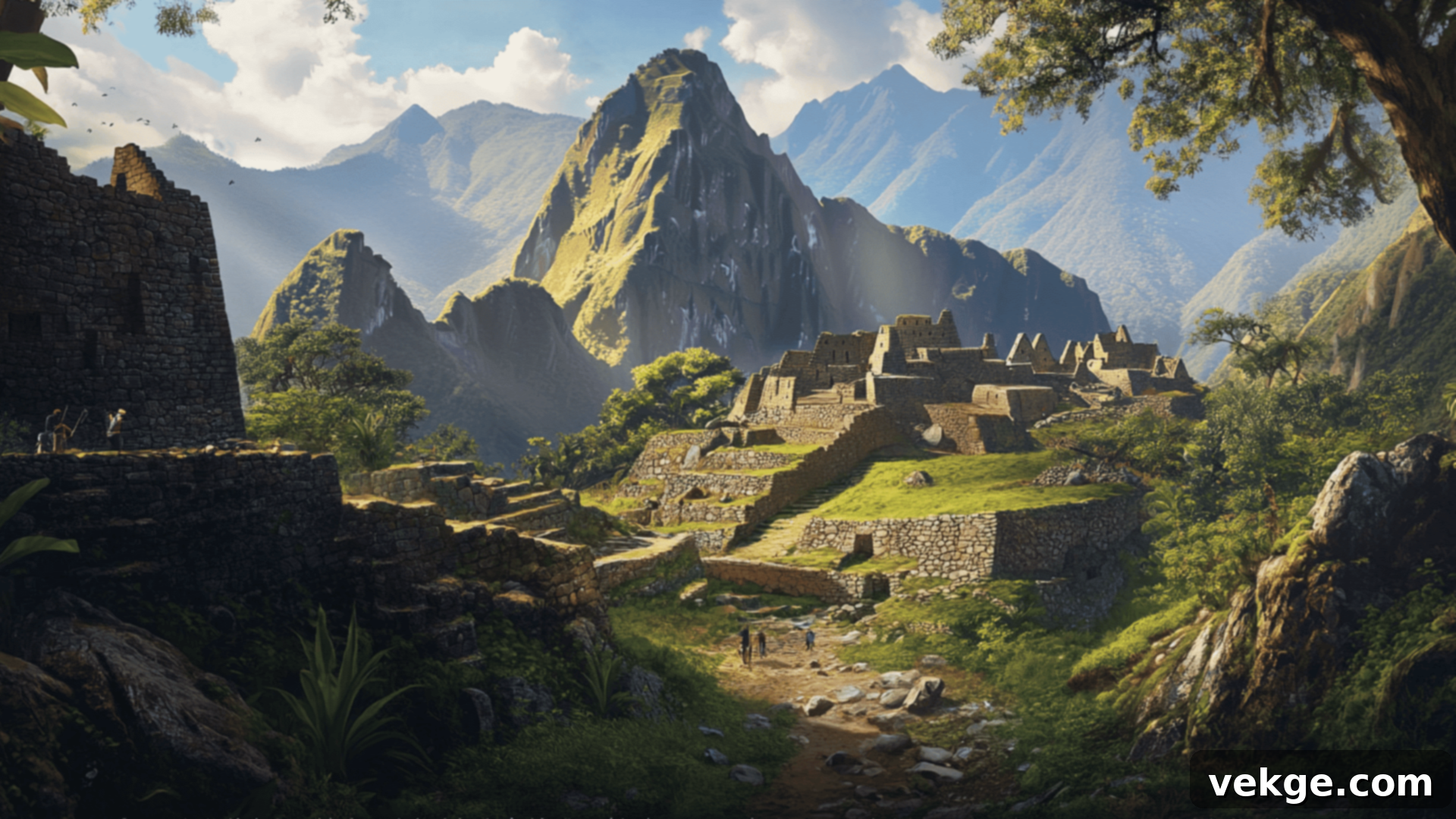Discover the Best of Peru: Unforgettable Ancient Wonders and Breathtaking Natural Landmarks
Peru is a country that captivates with its profound history, vibrant indigenous cultures, and awe-inspiring natural landscapes. From the enigmatic ruins of ancient civilizations to the towering peaks of the Andes and the lush expanse of the Amazon Rainforest, Peru’s landmarks offer an extraordinary array of experiences for every type of traveler. This South American gem is home to world-renowned sites such as the iconic Machu Picchu, the mysterious Nazca Lines, and the vibrant cultural heart of Cuzco, each telling a compelling story of its rich past and dynamic present.
Whether you dream of embarking on an epic trek through the majestic Andes, exploring ancient Inca cities, or immersing yourself in the diverse ecosystems of its coastal deserts and rainforests, Peru promises an adventure that will leave a lasting impression. Its diverse geography and deep-rooted heritage ensure a journey filled with wonder and discovery.
In this comprehensive guide, we will delve into 36 of Peru’s most famous and interesting landmarks – places you absolutely won’t want to miss on your Peruvian adventure. Get ready to explore the wonders that make Peru an unparalleled destination.
Why Peru’s Landmarks Are Essential to Explore
Peru’s landmarks are much more than mere tourist attractions; they are living testaments to the country’s profound history, intricate cultural tapestry, and incredible natural diversity. These sites serve as vital links to the past, preserving the legacies of ancient civilizations such as the Incas, Nazca, and pre-Inca cultures, whose ingenuity and spirit continue to inspire today.
From the meticulously planned cities of the Inca Empire to the breathtaking natural formations shaped over millennia, each location offers a unique window into Peru’s journey through time. Visiting these iconic places helps us understand the sophisticated lives, beliefs, and societal structures of the people who shaped Peru, offering invaluable insights into their achievements and their deep connection to the land.
Engaging with these landmarks allows you to forge a personal connection with Peru’s rich heritage, while simultaneously immersing yourself in the country’s stunning natural beauty. This blend of historical significance and breathtaking scenery is what makes Peru truly special, creating memorable experiences that resonate long after your visit.
1. Machu Picchu: The Lost City of the Incas

Overview: Perched majestically high in the Andes Mountains, Machu Picchu stands as the enduring symbol of the Inca Empire. This ancient citadel, built in the 15th century by Emperor Pachacuti, remained remarkably hidden from the Spanish conquistadors for centuries, only to be brought to global attention by Hiram Bingham in 1911. Its sophisticated dry-stone construction, intricate terraces, and panoramic views make it an architectural marvel.
Facts:
- It was constructed around 1450 AD, during the height of the Inca Empire.
- Discovered by explorer Hiram Bingham III in 1911, although local farmers were aware of its existence.
- Designated a UNESCO World Heritage site in 1983 and recognized as one of the New Seven Wonders of the World.
- The site’s precise stone masonry, without mortar, has withstood centuries of earthquakes.
Why Visit: A journey to Machu Picchu is an unforgettable experience, offering not only breathtaking vistas but also a profound connection to a lost civilization. Whether you choose the iconic Inca Trail trek, the shorter Salkantay route, or a scenic train ride, reaching this site is a bucket-list achievement. Explore its temples, palaces, and agricultural terraces, marveling at the ingenuity of the Inca people amidst stunning cloud forest scenery.
Interesting Fact: Despite extensive research, the exact original purpose of Machu Picchu continues to intrigue historians and archaeologists. While commonly believed to be a royal estate for the Inca emperor or a sacred religious site, its exact function remains a captivating mystery, adding to its allure.
2. Nazca Lines: Ancient Geoglyphs in the Desert
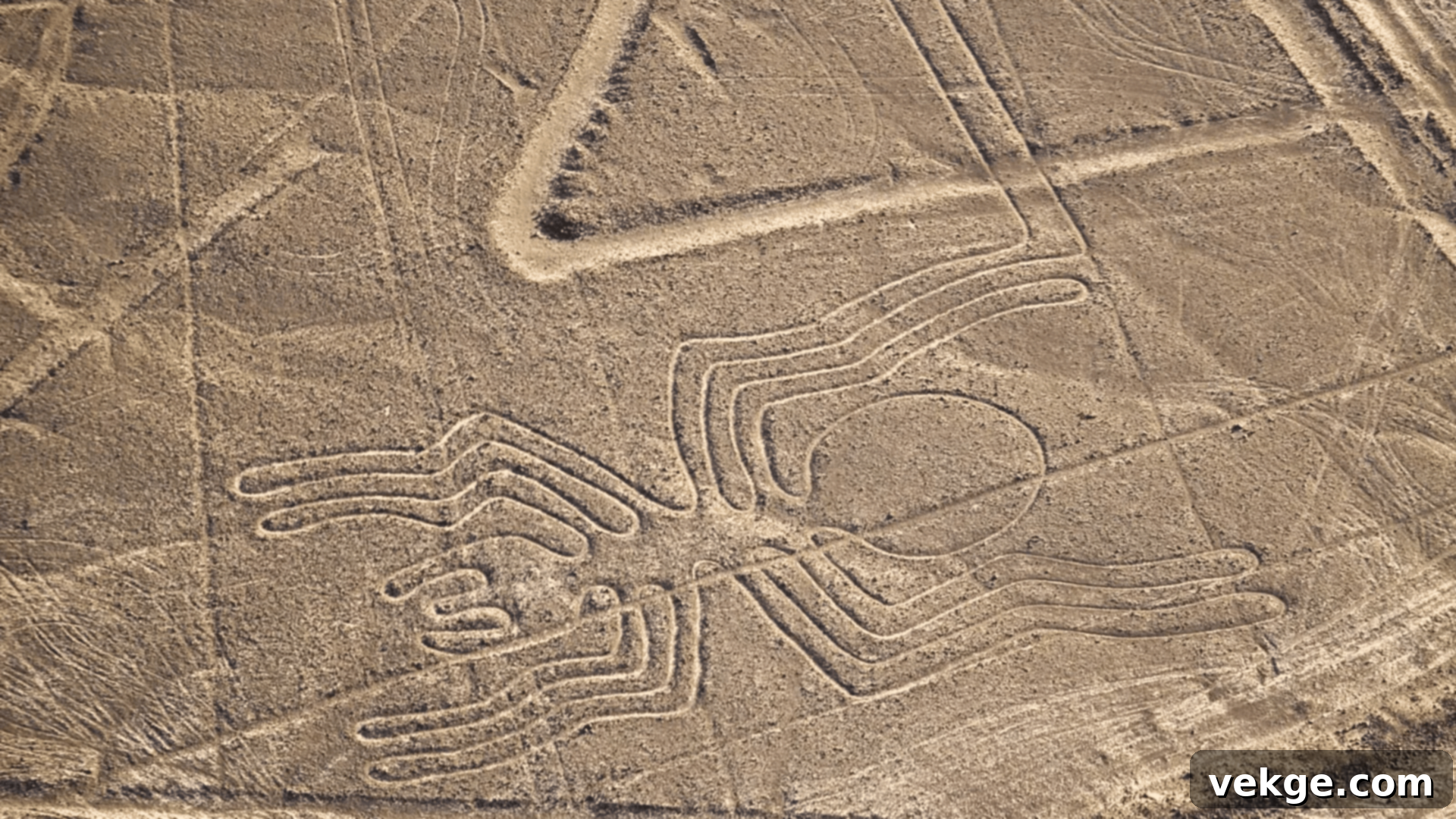
Overview: The Nazca Lines are a series of massive geoglyphs etched into the arid desert plains of Peru. These mysterious designs, ranging from simple lines and geometric shapes to intricate depictions of animals like hummingbirds, monkeys, and spiders, cover an area of about 450 square kilometers. They represent a remarkable artistic and engineering feat by the ancient Nazca people.
Facts:
- Some of the lines stretch for over 1,000 feet, showcasing the immense scale of the ancient Nazca artists.
- They were created by the Nazca culture between 500 BCE and 500 CE.
- The geoglyphs are best viewed from the air, which makes their purpose even more puzzling.
- Created by removing reddish-brown iron oxide-coated pebbles to expose lighter soil beneath.
Why Visit: The sheer scale and enduring mystery surrounding the Nazca Lines make them an incredibly fascinating site. Taking a flight over the desert offers a unique perspective to fully appreciate these monumental ancient artworks. It’s an opportunity to ponder the motivations and methods of a sophisticated civilization that left behind such an indelible mark.
Interesting Fact: The exact purpose of the Nazca Lines is still widely debated among scholars. Theories range from astronomical calendars, ritual pathways, and offerings to deities, to even landing strips for extraterrestrial beings, adding to their enigmatic appeal.
3. Lake Titicaca: The Birthplace of the Sun
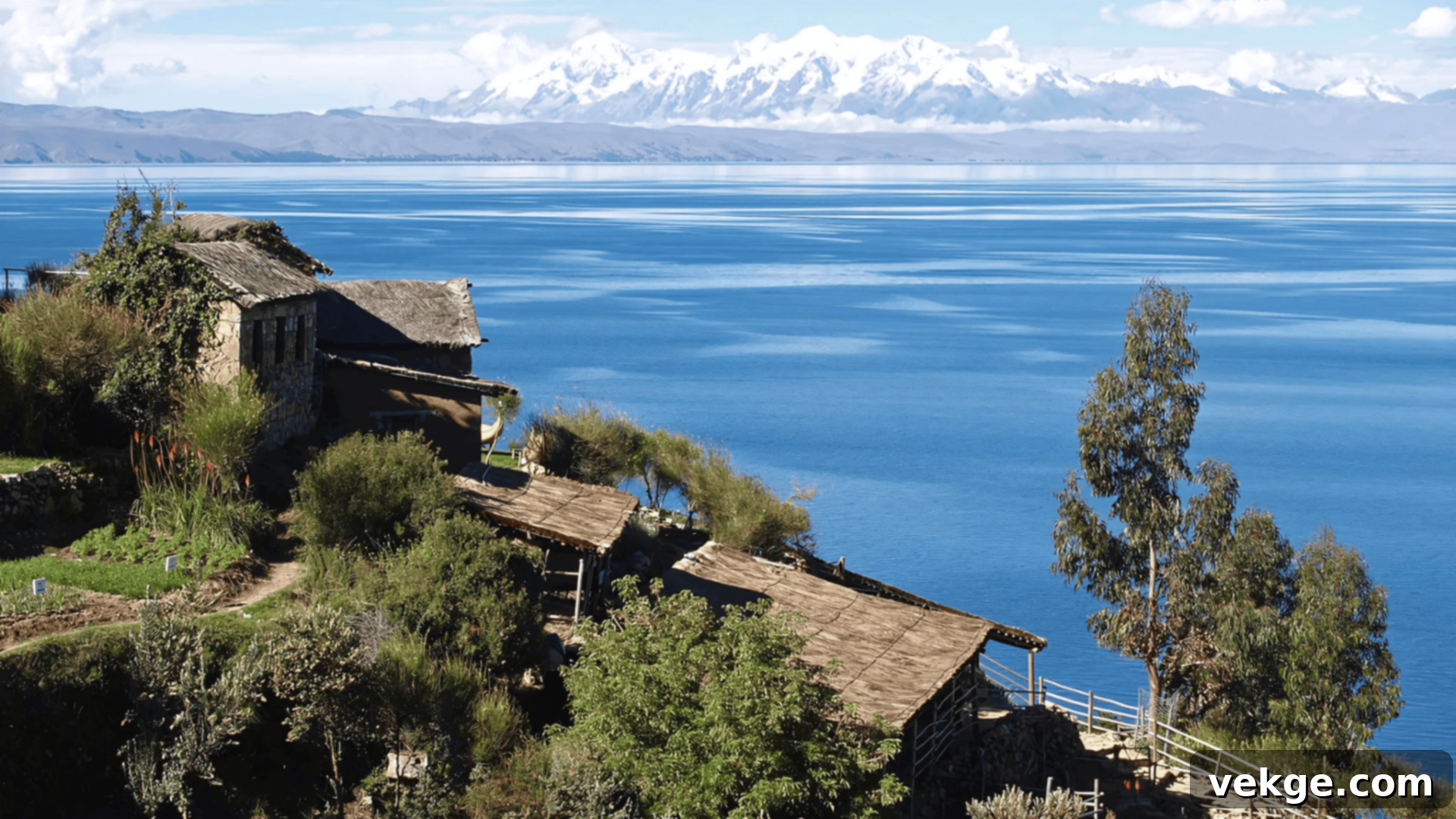
Overview: Lake Titicaca, straddling the border between Peru and Bolivia, holds the distinction of being the highest navigable lake in the world. This expansive body of water is not only geographically remarkable but also deeply significant in Andean mythology, believed to be the birthplace of the sun and the cradle of the Inca civilization. Its deep blue waters are surrounded by a landscape rich in indigenous culture.
Facts:
- Located at an astounding elevation of 12,500 feet (3,810 meters) above sea level.
- It is home to the Uros people, who ingeniously live on unique floating islands crafted entirely from totora reeds.
- The lake is the largest in South America by volume.
- Several islands within the lake, such as Taquile and Amantani, offer insights into traditional Andean life.
Why Visit: A visit to Lake Titicaca offers a profound cultural immersion and stunning natural beauty. You can explore the fascinating floating islands of the Uros, learning about their unique way of life, or venture to other islands like Taquile to experience ancient weaving traditions and breathtaking panoramic views. It’s a serene and culturally rich destination perfect for experiencing authentic Andean heritage.
Interesting Fact: According to Inca legends, Lake Titicaca is the sacred site where the sun god Inti was born, and from whose depths Viracocha, the creator god, emerged to create the first humans, Manco Cápac and Mama Ocllo, who founded the Inca Empire.
4. Colca Canyon: The Realm of the Condor
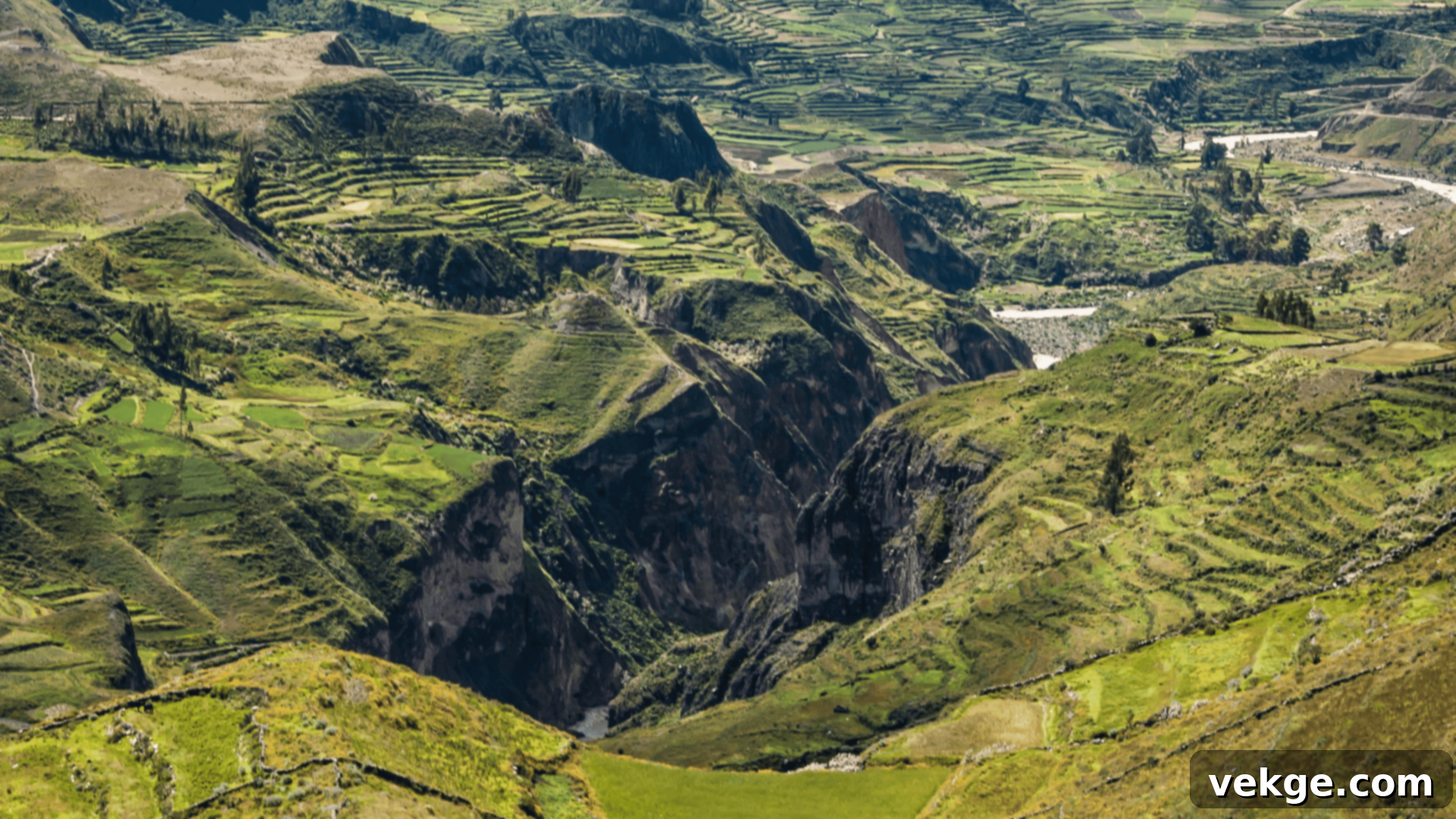
Overview: Colca Canyon, nestled in the Arequipa region, is one of the world’s deepest canyons, often cited as being more than twice as deep as the Grand Canyon in the United States. Carved by the Colca River, this dramatic natural wonder is characterized by its steep, terraced walls and stunning panoramic views, making it a prime destination for adventure and nature lovers.
Facts:
- Its maximum depth is approximately 3,270 meters (10,730 feet), making it one of the deepest on Earth.
- It is famously known as one of the best places in the world to observe the majestic Andean condor in flight.
- Pre-Inca terraces, still in use today, line the canyon walls, showcasing ancient agricultural ingenuity.
- The Colca River runs through the canyon, offering opportunities for rafting.
Why Visit: Colca Canyon is an unparalleled destination for hiking, trekking, and especially birdwatching. Witnessing the giant Andean condors gracefully soaring on thermal currents at viewpoints like Cruz del Cóndor is an unforgettable spectacle. The challenging trails and stunning scenery appeal to adventurers, while the cultural immersion with local communities adds another layer to the experience.
Interesting Fact: Beyond its impressive depth and condor population, Colca Canyon is also home to ancient terraced fields that predate the Incas. These remarkable agricultural systems demonstrate sophisticated engineering, allowing cultivation on steep slopes and contributing to the region’s food security for centuries.
5. Sacred Valley of the Incas: A Historical Heartland
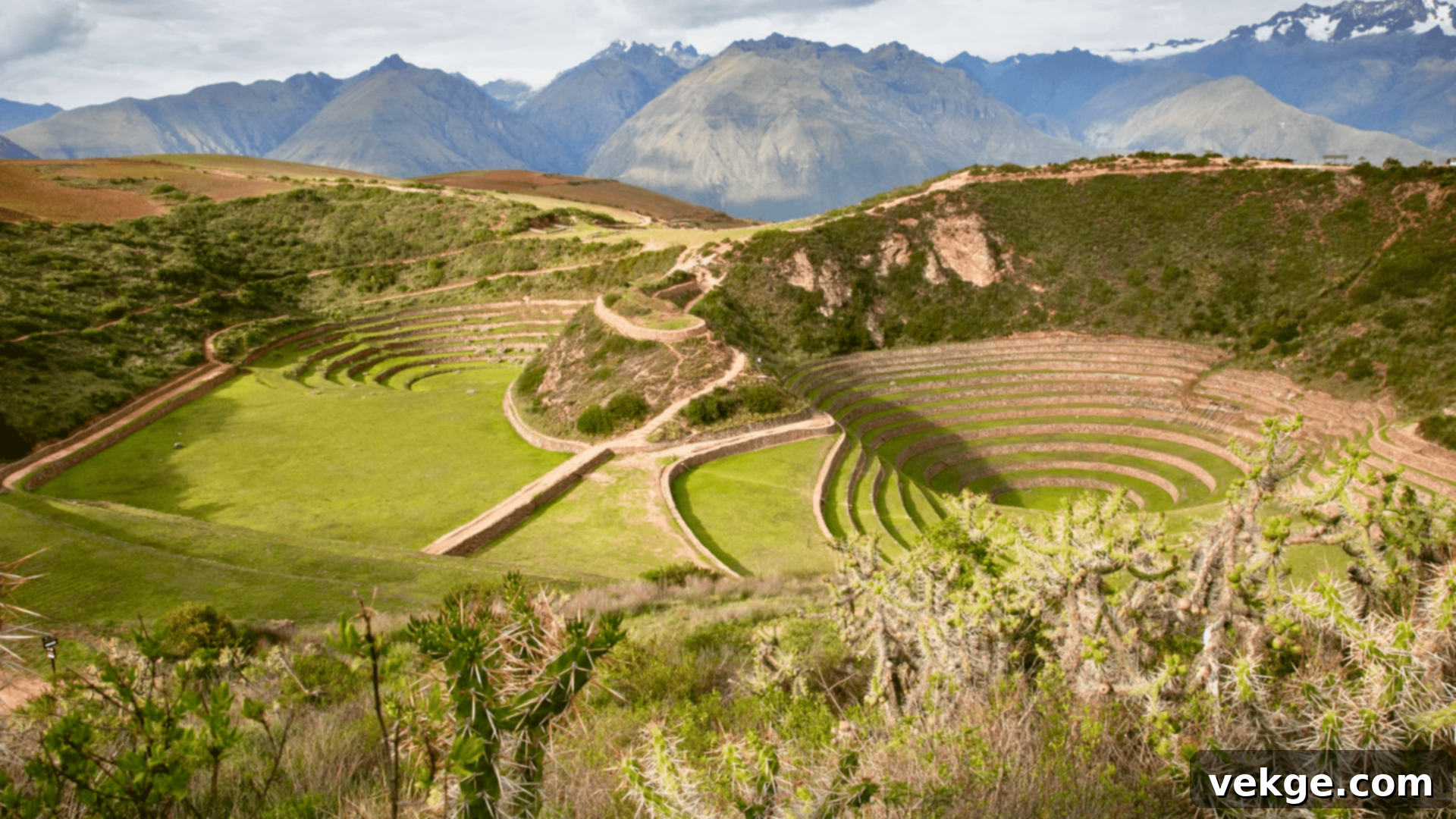
Overview: The Sacred Valley, or Valle Sagrado, is a breathtaking stretch of land in the Andean highlands of Peru, snaking between the towns of Pisac and Machu Picchu. This fertile valley was once the heartland of the Inca Empire, renowned for its rich agricultural lands, strategically important fortresses, and significant ceremonial sites. It’s cradled by towering mountains and nourished by the Urubamba River.
Facts:
- Situated conveniently between the Inca capital of Cuzco and the iconic citadel of Machu Picchu.
- It is famous for its exceptionally fertile lands, which the Incas utilized for cultivating maize and other crops.
- Home to numerous impressive ancient Inca ruins, including the vibrant market town and archaeological site of Pisac, and the colossal fortress of Ollantaytambo.
- The valley enjoys a milder climate than Cuzco due to its lower elevation.
Why Visit: Exploring the Sacred Valley provides an incredible opportunity to delve deep into Incan history and appreciate the ingenious engineering and agricultural prowess of their civilization. Beyond the historical sites, visitors can enjoy breathtaking landscapes, vibrant local markets, and a chance to experience traditional Andean life. It’s an ideal complement to a Machu Picchu visit, offering a deeper understanding of the Inca world.
Interesting Fact: The Sacred Valley was considered a vital sacred area by the Incas, not only for its agricultural bounty but also for its spiritual significance. The Urubamba River, which flows through it, was seen as a terrestrial reflection of the Milky Way, a celestial river central to Inca cosmology.
6. Cuzco: The Ancient Capital of the Inca Empire
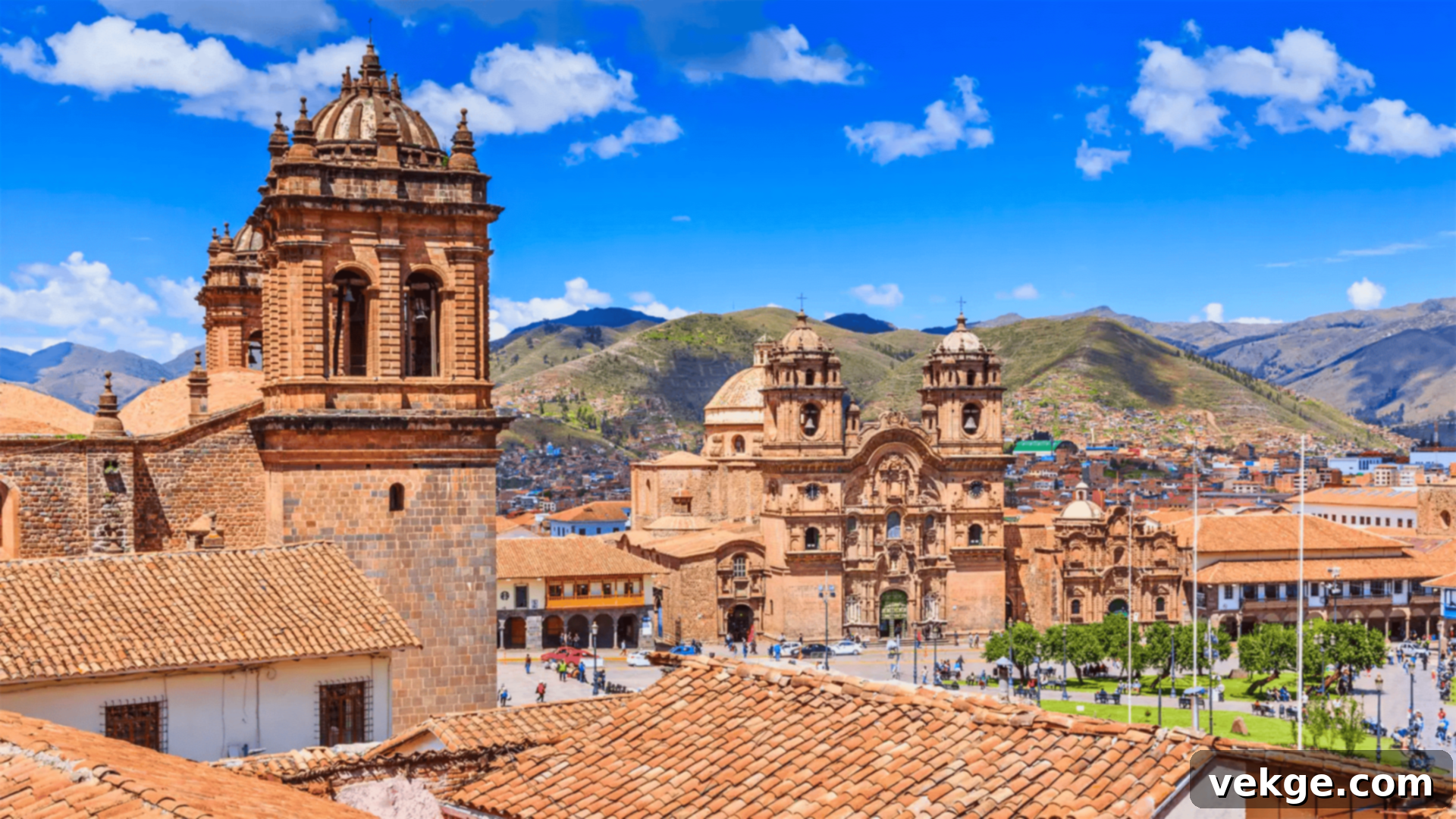
Overview: Cuzco, often spelled Cusco, is a city steeped in history and vibrant culture, serving as the majestic capital of the Inca Empire before the Spanish conquest. Today, it stands as a testament to the seamless fusion of Inca foundations and colonial Spanish architecture, with its cobblestone streets and plazas echoing tales of empires past. Its high-altitude setting adds to its mystique and charm.
Facts:
- It showcases a unique blend of colonial architecture built directly upon ancient Inca stone foundations.
- Declared a UNESCO World Heritage site in 1983, recognizing its immense historical and cultural value.
- The city’s central Plaza de Armas was the main square during the Inca Empire, then renamed by the Spanish.
- Cuzco is the most important gateway for travelers heading to Machu Picchu and the Sacred Valley.
Why Visit: Cuzco is not just a city; it’s an experience. It serves as the perfect vibrant base for exploring the Sacred Valley and Machu Picchu, offering a rich tapestry of museums, ancient ruins, stunning churches, and bustling markets. Immerse yourself in its lively atmosphere, taste traditional Peruvian cuisine, and explore archaeological sites like Qorikancha and Sacsayhuamán, which are easily accessible from the city center.
Interesting Fact: In Inca tradition, Cuzco was considered the “navel of the world” (Qosqo in Quechua), reflecting its central importance in their vast empire. The city was meticulously planned in the shape of a puma, a sacred animal, with Sacsayhuamán representing its head.
7. Arequipa: The White City of Peru
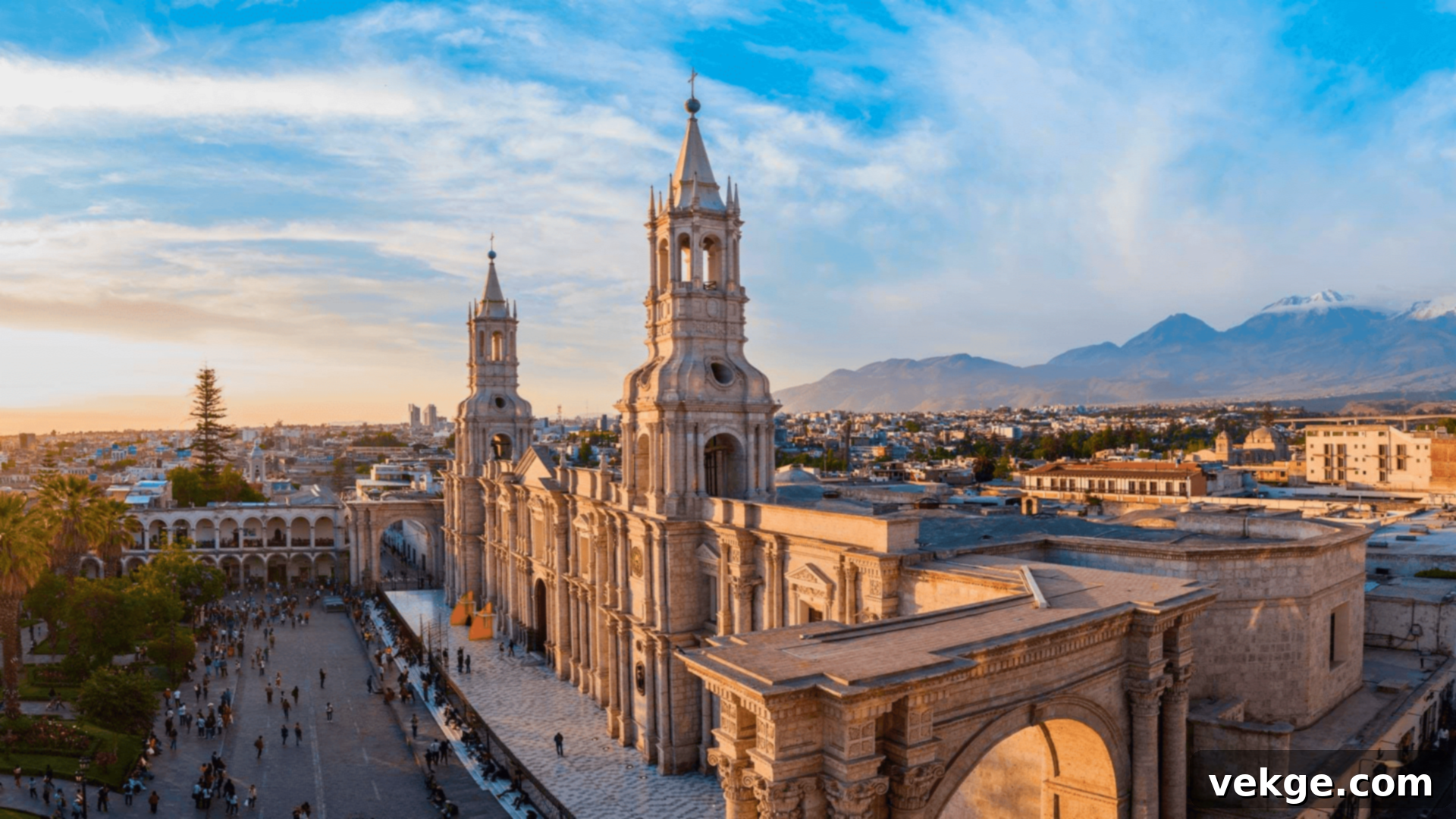
Overview: Arequipa is a stunning colonial city in southern Peru, often referred to as “The White City” due to its magnificent buildings constructed from sillar, a gleaming white volcanic stone. This beautiful city is dramatically framed by three majestic snow-capped volcanoes: El Misti, Chachani, and Pichu Pichu, creating a picturesque backdrop to its rich architectural heritage.
Facts:
- It earned its nickname “The White City” from the predominant use of sillar, a light-colored volcanic rock, in its architecture.
- The historic center of Arequipa is a UNESCO World Heritage site, celebrated for its unique blend of European and indigenous building techniques.
- The Santa Catalina Monastery, a vivid and sprawling complex, is one of its most famous landmarks and a city within a city.
- Arequipa is Peru’s second-most populous city.
Why Visit: Arequipa offers a captivating blend of unique colonial architecture, vibrant cultural life, and stunning natural scenery. Explore its charming plazas, visit the awe-inspiring Santa Catalina Monastery, and savor the distinctive local cuisine, which is celebrated as some of the best in Peru. The surrounding volcanic landscape provides fantastic opportunities for outdoor activities and breathtaking views.
Interesting Fact: Arequipa sits in the literal shadow of three impressive snow-capped volcanoes, which have historically shaped its geology, architecture, and even its resilient spirit. The volcanic rock, sillar, used in its buildings, is quarried from these surrounding formations.
8. Paracas National Reserve: Coastal Wildlife and Desert Landscapes
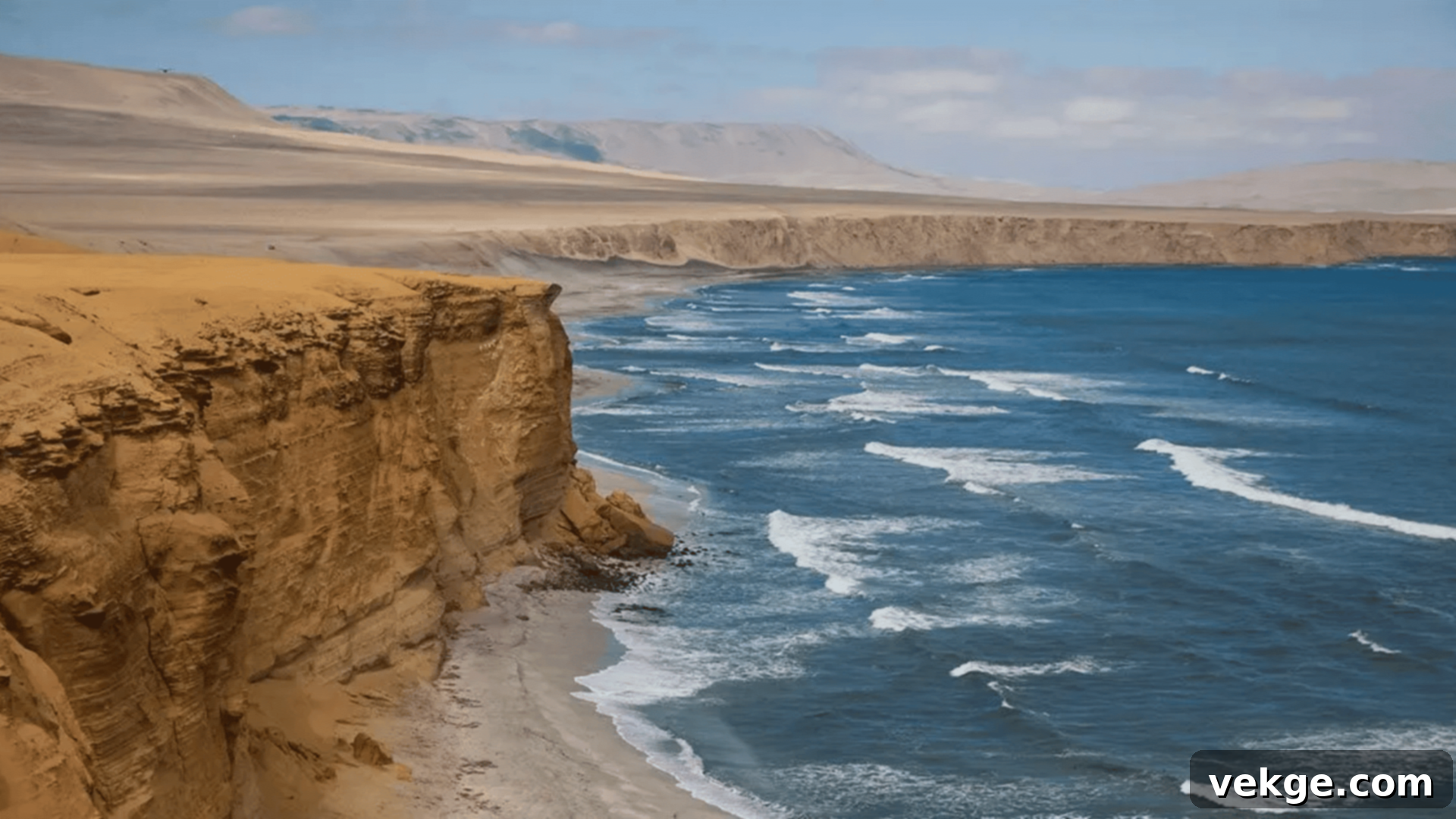
Overview: The Paracas National Reserve is a protected coastal area on the Pacific coast of Peru, renowned for its dramatic desert landscapes, pristine beaches, and incredibly rich marine wildlife. This unique ecosystem encompasses desert, ocean, and the stunning Paracas Peninsula, offering a stark yet beautiful contrast of red sand dunes meeting the blue sea.
Facts:
- It is famous for its abundant wildlife, including significant populations of sea lions, various bird species, and Humboldt penguins.
- The reserve is home to the Ballestas Islands, often affectionately called the “Poor Man’s Galapagos” due to their incredible biodiversity.
- Established in 1975, it’s Peru’s only marine protected area, safeguarding both its unique ecosystem and archaeological sites.
- The Candelabra of the Andes, a massive geoglyph, is also visible from the boat tours.
Why Visit: Paracas National Reserve is an ideal destination for eco-tourism and unparalleled wildlife watching. Take a boat tour to the Ballestas Islands to witness sea lions, diverse bird species, and penguins in their natural habitat. Explore the reserve’s dramatic desert beaches and rugged coastline, offering stunning photographic opportunities and a chance to connect with raw, untamed nature.
Interesting Fact: Beyond its natural beauty and wildlife, Paracas is also an important archaeological site, home to remnants of the ancient Paracas culture. This pre-Inca civilization was known for its sophisticated textiles and trepanation (skull surgery), adding a fascinating historical layer to the reserve.
9. The Peruvian Amazon Rainforest: Biodiversity Hotspot
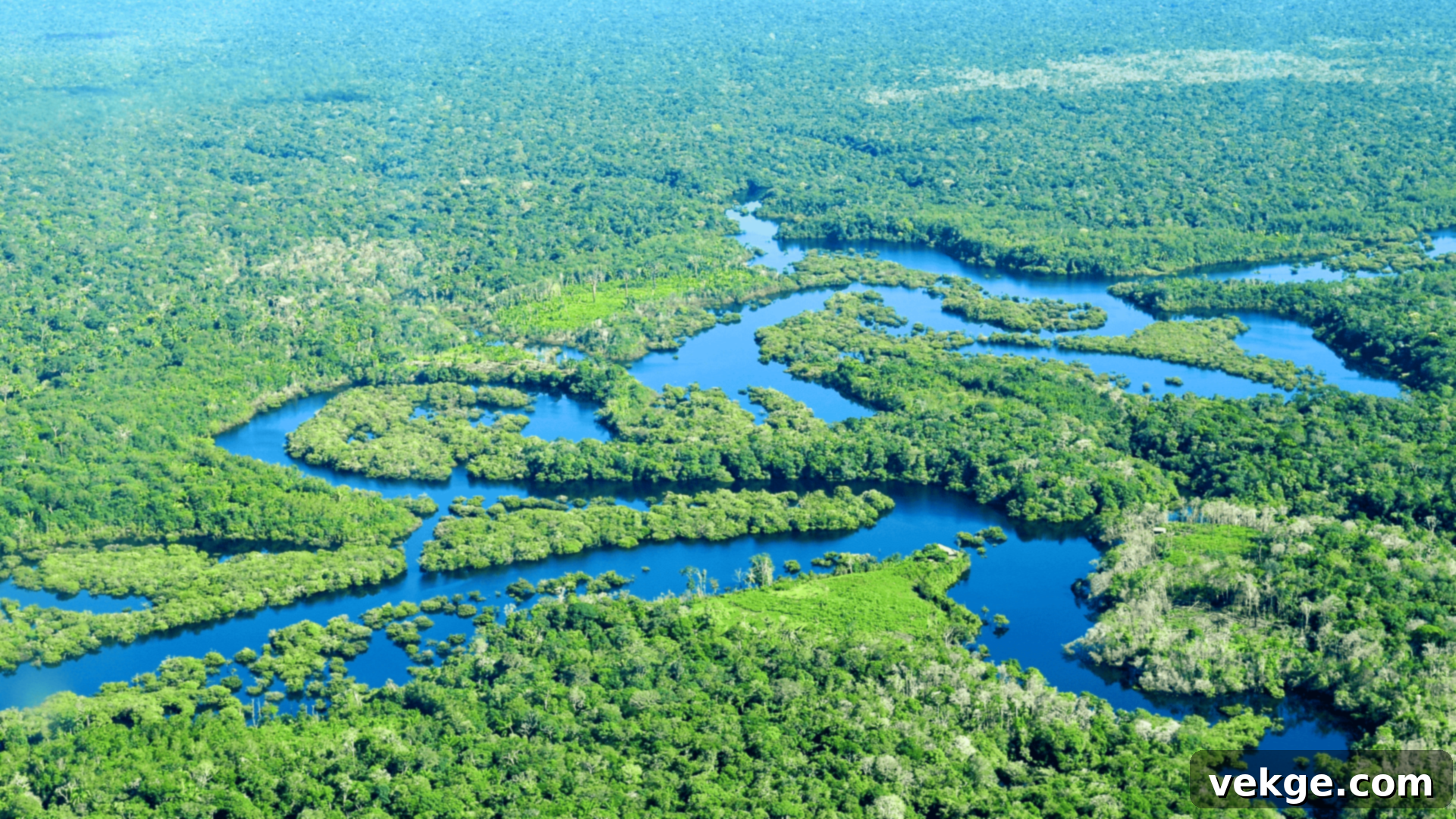
Overview: The Amazon Rainforest, the largest tropical rainforest in the world, covers a significant portion of eastern Peru, making it one of the country’s most vital and biodiverse regions. This vast expanse of dense jungle is crisscrossed by the mighty Amazon River and its tributaries, forming an intricate network that supports an astonishing variety of plant and animal life.
Facts:
- It is home to an immense variety of plant and animal species, making it one of the planet’s most biodiverse regions.
- While spanning many countries, large and pristine parts of the Amazon Rainforest are located within Peru.
- Peru’s Amazon basin is a major ecotourism destination, with gateways like Iquitos and Puerto Maldonado.
- Indigenous communities thrive within the Peruvian Amazon, preserving ancient traditions and knowledge.
Why Visit: Visiting the Peruvian Amazon offers an incredible opportunity to experience diverse ecosystems and encounter unique wildlife up close. Embark on river cruises, jungle treks, and guided excursions to spot monkeys, sloths, vibrant birds, caimans, and jaguars. It’s a truly immersive adventure for nature enthusiasts, providing a deep appreciation for one of Earth’s most crucial natural wonders.
Interesting Fact: Often referred to as the “lungs of the Earth,” the Amazon Rainforest plays a critical role in global climate regulation, producing an estimated 20% of the world’s oxygen. Its staggering biodiversity means that new species are still being discovered regularly.
10. Huacachina Oasis: A Desert Paradise
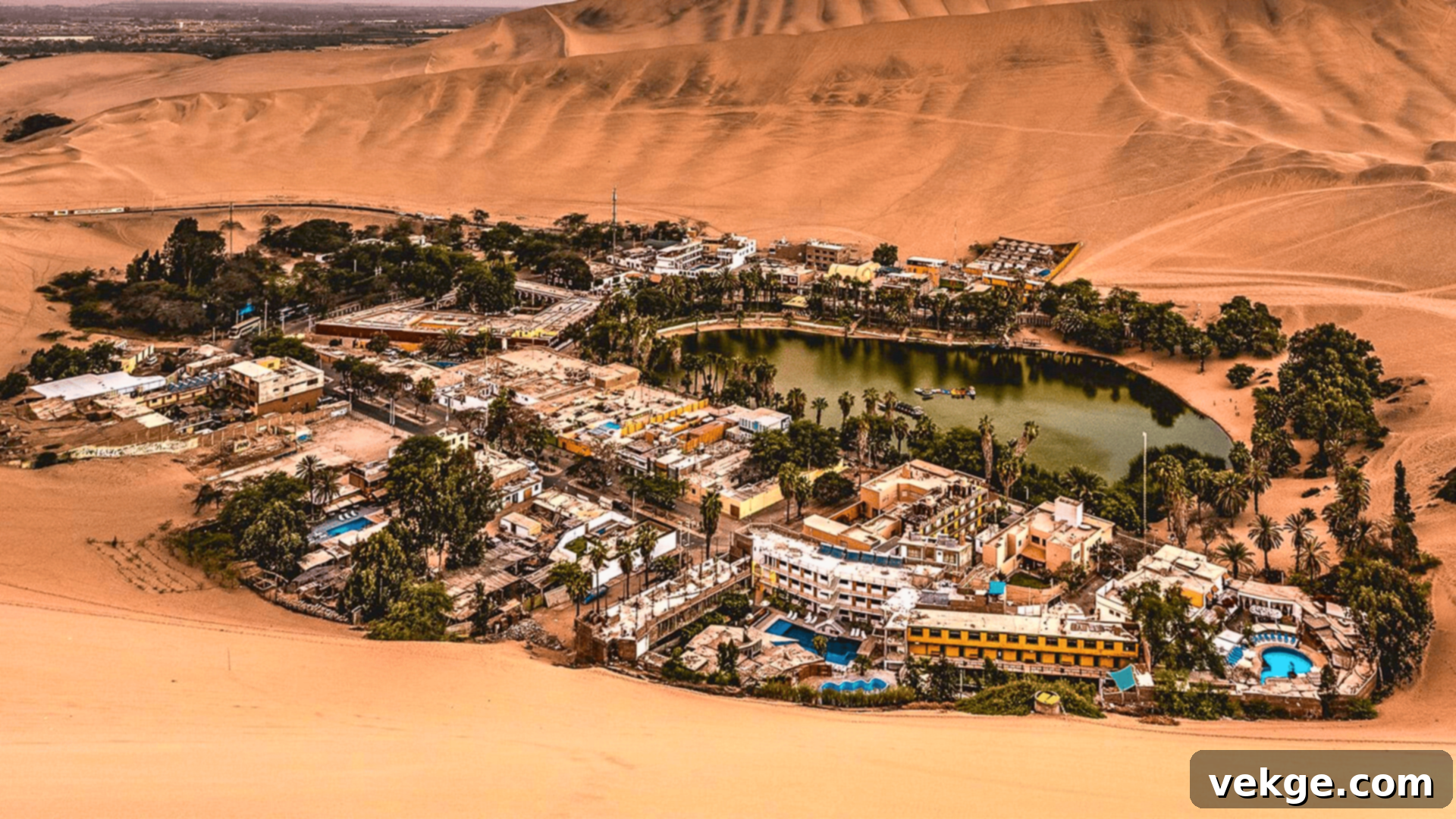
Overview: Huacachina is a picturesque desert oasis nestled in the Ica region of Peru, distinguished by a natural lagoon surrounded by towering sand dunes. This enchanting little village, with its palm trees and lush vegetation, creates a stark and beautiful contrast against the golden desert landscape, offering a unique blend of tranquility and adventure.
Facts:
- It is widely known for exhilarating adventure sports, particularly sandboarding and dune buggy rides across the immense sand dunes.
- The oasis features a charming, emerald-green lagoon at its center, fed by subterranean waters.
- Huacachina is one of the very few natural oases remaining in North and South America.
- The town itself has a small permanent population and thrives on tourism.
Why Visit: Huacachina is a fantastic destination for both relaxation and adventurous activities. Spend your days enjoying the thrill of speeding down sand dunes on a sandboard or roaring through the desert on a dune buggy. In the evenings, relax by the lagoon, enjoying the serene atmosphere and breathtaking sunset views over the desert. It’s a truly unique experience in Peru.
Interesting Fact: The legend of Huacachina tells the story of a beautiful Inca princess, Huacachina, who mourned a lost love. Her tears created the lagoon, and she herself transformed into a mermaid who still lives in its waters. This romantic tale adds to the oasis’s mystical charm.
11. Lima’s Historic Center: Colonial Grandeur
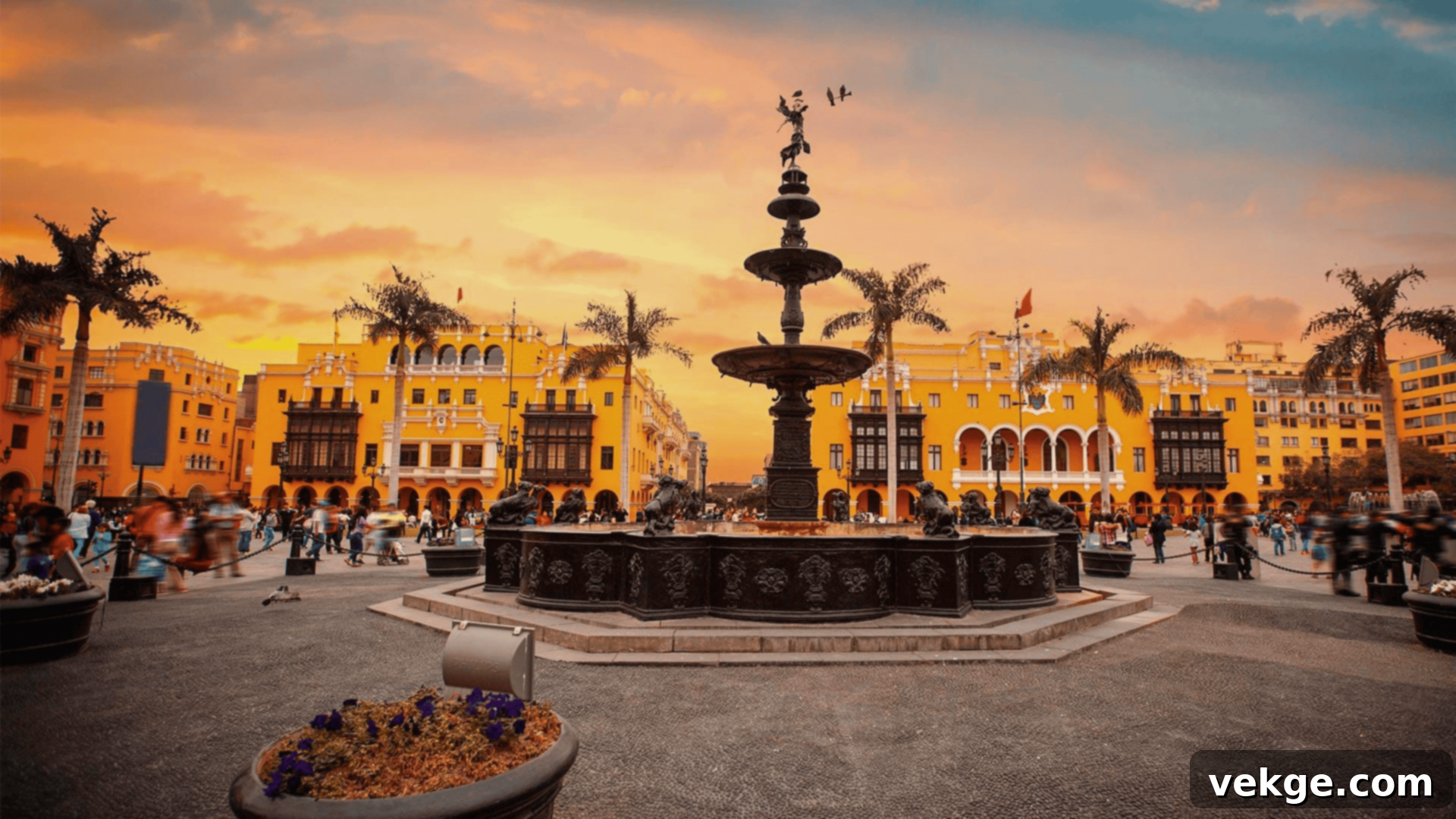
Overview: The Historic Center of Lima, the bustling capital of Peru, represents the heart of its colonial past. This area is a magnificent showcase of Spanish architectural influence, featuring grand plazas, opulent palaces, and stunning churches that date back to the 16th century. It vividly reflects Lima’s historical prominence as a major center of Spanish rule in South America.
Facts:
- It features iconic colonial buildings such as the Plaza Mayor (or Plaza de Armas), the Government Palace, and the magnificent Cathedral of Lima.
- The Historic Center of Lima was designated a UNESCO World Heritage site in 1988 for its exceptional collection of historic monuments.
- Many buildings exhibit intricate wooden balconies, a distinctive feature of Lima’s colonial architecture.
- The area is also home to the eerie catacombs beneath the Monastery of San Francisco.
Why Visit: A visit to Lima’s Historic Center is an immersive journey into Peru’s colonial heritage. Explore its grand plazas, marvel at the ornate facades of its churches and government buildings, and soak in the lively atmosphere. It’s a perfect place to learn about Lima’s foundational history and witness the enduring legacy of Spanish rule, while also experiencing the vibrant pulse of modern Peruvian life.
Interesting Fact: During the Spanish colonial period, Lima was the most important and powerful city in South America, serving as the capital of the Viceroyalty of Peru. Its strategic importance and wealth attracted artisans and architects, leading to the construction of the stunning structures that define its historic center today.
12. Sacsayhuamán: The Inca Fortress Above Cuzco
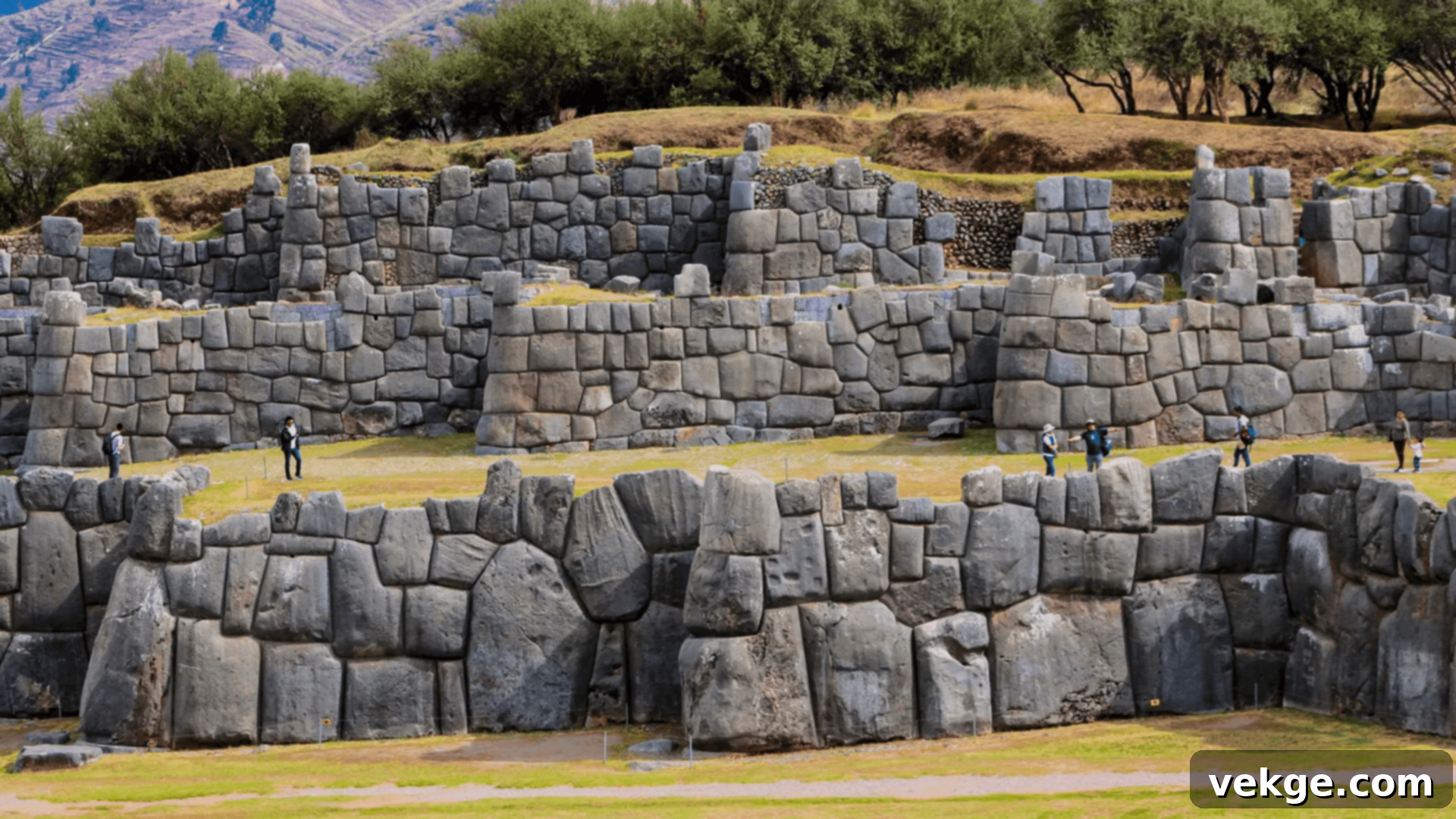
Overview: Sacsayhuamán is a monumental Inca archaeological site located on a steep hill overlooking the city of Cuzco. This impressive fortress complex is celebrated for its massive, precisely cut, and perfectly fitted megalithic stone walls, some of which feature individual stones weighing over 100 tons. Its strategic location suggests it served both ceremonial and defensive purposes.
Facts:
- It is known for its colossal zigzagging walls constructed with giant, multi-ton stones, some of the largest used in any pre-Columbian structure.
- Served as a crucial ceremonial site for important Inca festivals and rituals, as well as a formidable defense site during the Spanish conquest.
- The construction displays an incredible mastery of Inca stonework, where stones fit together so tightly that no mortar was needed, even after centuries.
- Offers panoramic views of Cuzco and the surrounding valley.
Why Visit: Sacsayhuamán offers visitors a truly awe-inspiring experience of Inca engineering and architectural prowess. Wander through its vast grounds, marvel at the sheer scale of the stonework, and imagine the vibrant ceremonies that once took place here. The site also provides spectacular panoramic views of Cuzco city, making it a perfect spot for photography and historical reflection.
Interesting Fact: The construction of Sacsayhuamán is an incredible feat of Inca engineering and labor, carried out without the use of wheels or iron tools. Historians estimate that tens of thousands of laborers were involved in quarrying, transporting, and precisely fitting these massive stones over many decades.
13. Choquequirao: The “Other Lost City” of the Incas
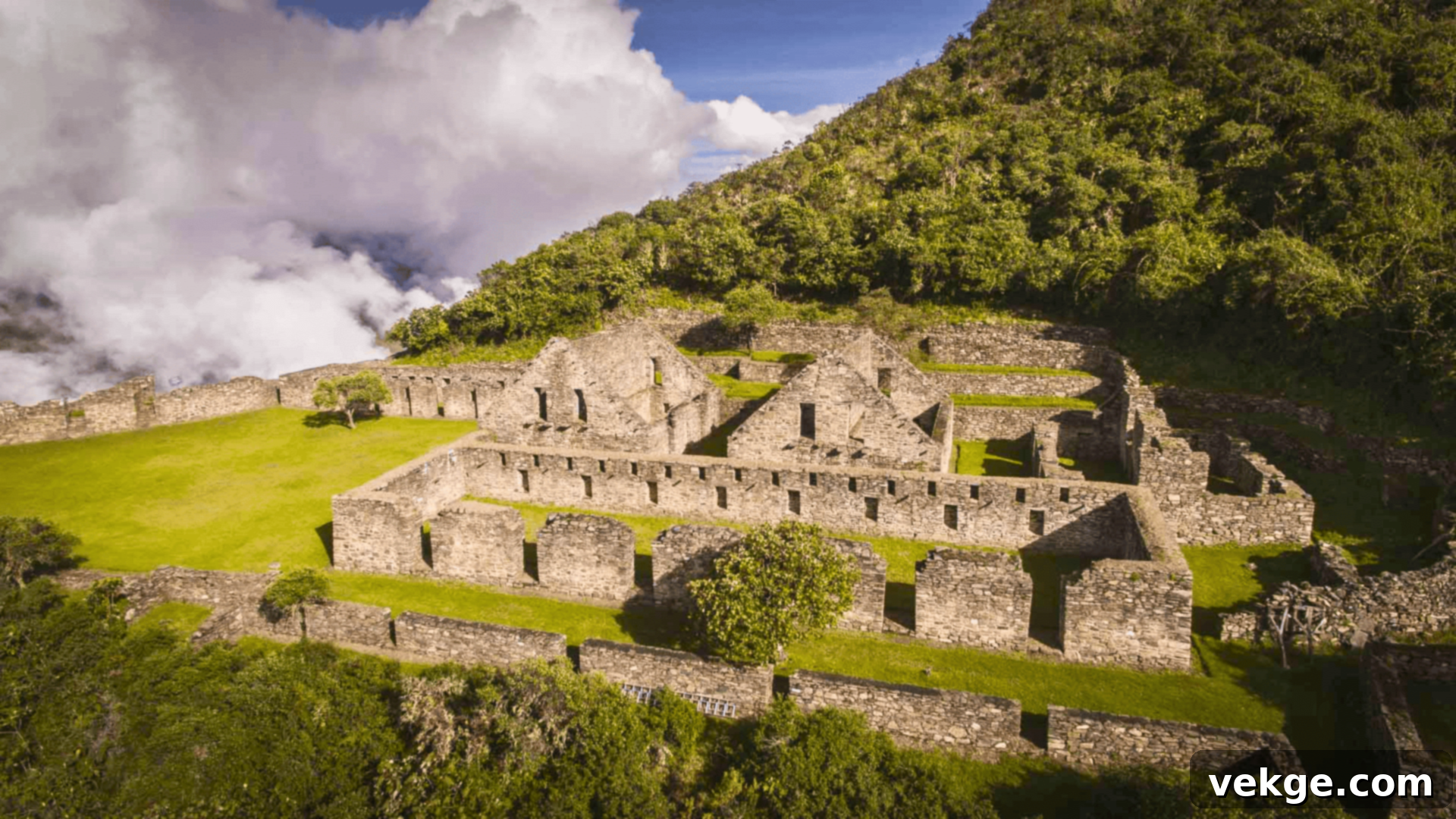
Overview: Choquequirao, often referred to as the “sister city” of Machu Picchu, is another magnificent ancient Inca site perched high in the remote Andes Mountains of Peru. This sprawling complex, much larger than Machu Picchu, is less accessible and therefore offers a more rugged and adventurous experience, revealing more of the Inca Empire’s hidden gems.
Facts:
- Often called the “sister city” of Machu Picchu due to its similar architectural style and strategic mountaintop location.
- The site is only accessible by a challenging multi-day trek, which contributes to its untouched and mystical atmosphere.
- Only about 30-40% of the site has been excavated, leaving much to be discovered.
- Features temples, ritual baths, and agricultural terraces carved into the steep mountainsides.
Why Visit: For adventurers seeking a truly immersive and less crowded historical experience, Choquequirao is an unparalleled destination. The challenging trek to reach the site rewards visitors with an equally spectacular, yet more secluded, glimpse into Inca civilization. It’s an opportunity to connect with ancient history and stunning natural beauty away from the main tourist trails.
Interesting Fact: Choquequirao is thought to have been a major religious and administrative center, possibly even a royal retreat, for the Incas during their final years of resistance against the Spanish. Its remote location likely served as a strategic hideaway and a symbolic bastion of Inca power.
14. Ollantaytambo: The Living Inca Town

Overview: Ollantaytambo is a charming Inca town and archaeological site situated in the Sacred Valley, renowned for its remarkably well-preserved Inca ruins and its unique status as one of the few Inca settlements still continuously inhabited. This strategic stronghold boasts impressive terraces and a formidable fortress that played a significant role in Inca history.
Facts:
- Known for its massive Inca terraces, which served both agricultural purposes and defensive fortifications, creating an imposing visual spectacle.
- Features an unfinished Inca temple complex at the top of the terraces, displaying colossal stone blocks.
- A crucial strategic point and a key stop along the Inca Trail route to Machu Picchu.
- The town itself maintains its original Inca street plan and water channels.
Why Visit: Ollantaytambo offers a unique opportunity to explore an ancient Inca town that still thrives today. Wander through its narrow streets, visit the impressive fortress and Sun Temple, and marvel at the incredible stonework. It’s a vital historical site and a picturesque village that serves as an excellent starting or ending point for various treks in the Sacred Valley.
Interesting Fact: Ollantaytambo is one of the few Inca sites that still preserves its original Inca urban planning and agricultural systems, making it a “living Inca town.” The intricate water channels, streets, and homes provide a tangible connection to how the Incas lived centuries ago.
15. Moray: The Inca Agricultural Laboratory
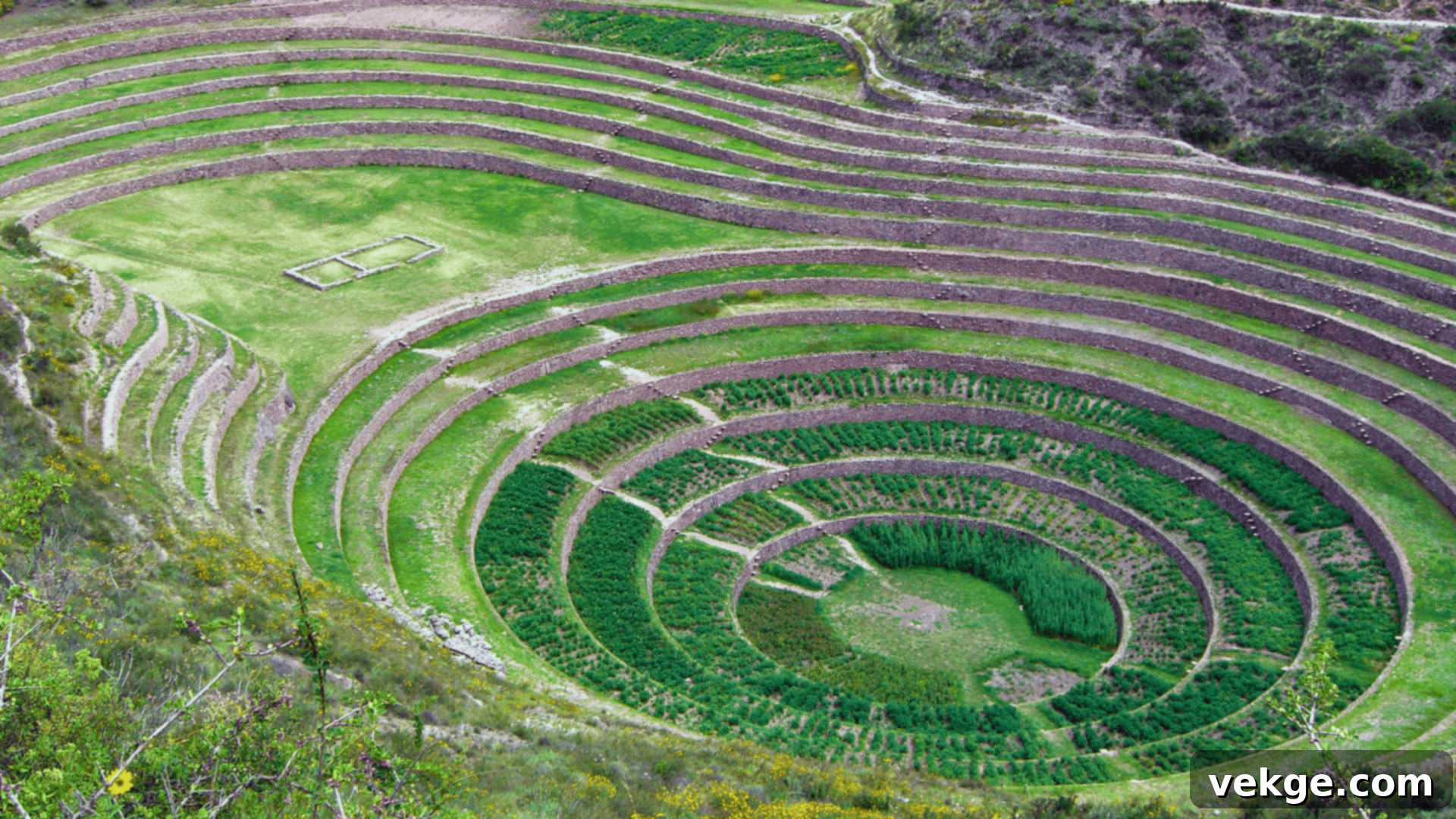
Overview: Moray is a fascinating archaeological site in the Sacred Valley of Peru, distinguished by its unique series of concentric circular terraces that descend deep into the earth. These distinct formations are believed to have served as an ancient Inca agricultural laboratory, where the Incas experimented with various crops under different microclimates.
Facts:
- Features multiple giant circular depressions, or terraces, resembling ancient amphitheaters, each with distinct temperature zones.
- Believed to have been used by the Incas for crop experimentation, simulating different ecological niches.
- Located conveniently in the Sacred Valley, making it a popular combined visit with the Maras Salt Mines.
- The deepest terrace at Moray measures approximately 30 meters (98 feet), with a temperature difference of up to 15 °C (27 °F) between the top and bottom.
Why Visit: A visit to Moray is a chance to witness the incredible agricultural ingenuity and scientific prowess of the Inca civilization. Explore these unique terraces and ponder how the Incas meticulously studied and adapted various crops to flourish in the challenging Andean environment. It offers a distinct perspective on their advanced knowledge of agronomy and engineering.
Interesting Fact: The sophisticated design of Moray’s terraces created a series of different microclimates, with temperatures varying significantly from the top to the bottom rings. This allowed the Incas to simulate a wide range of growing conditions and domesticate plants that would otherwise not survive at high altitudes.
16. Puno: Folklore Capital of Peru
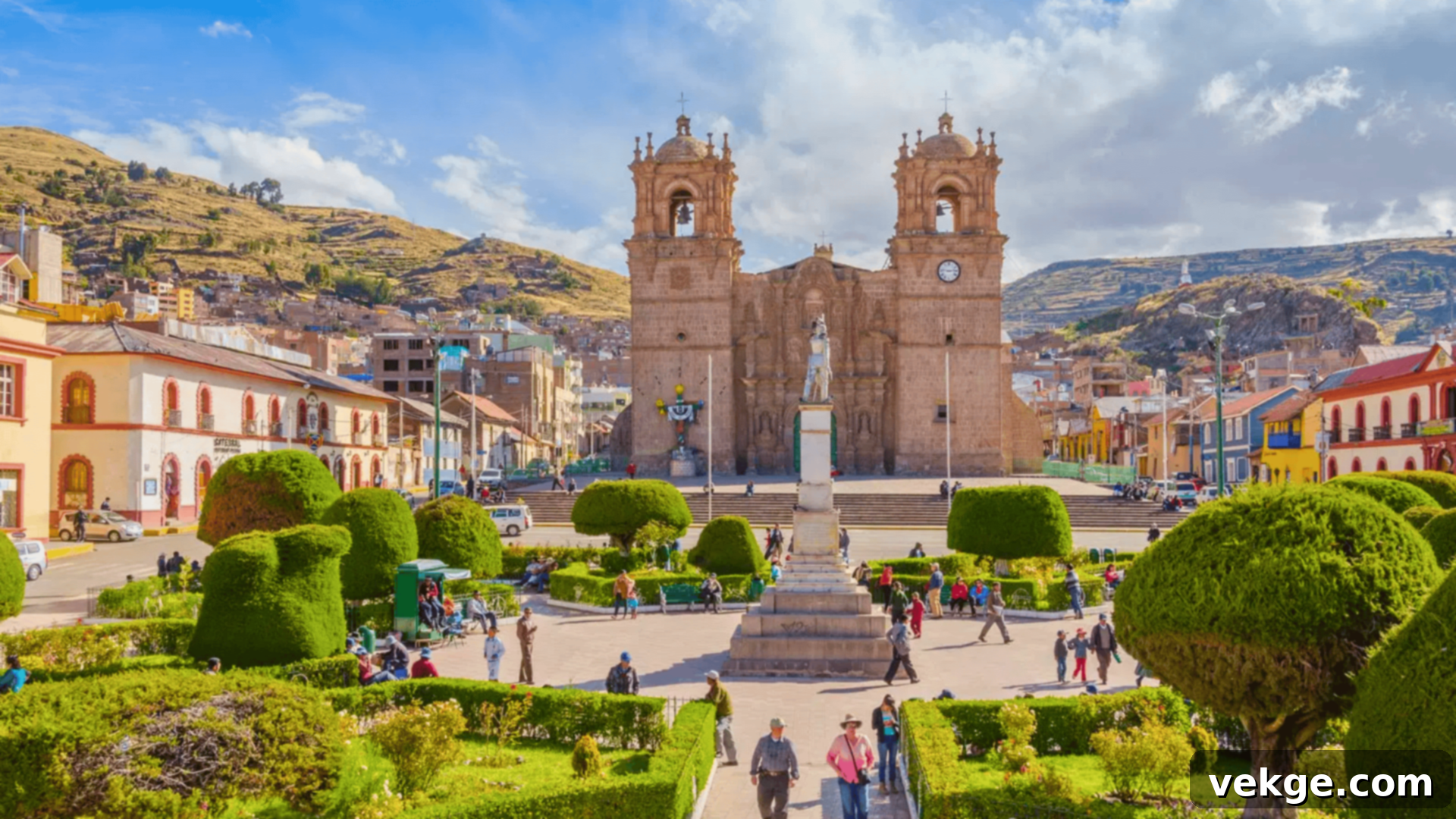
Overview: Puno is a bustling city located on the shores of Lake Titicaca, often hailed as the “Folklore Capital of Peru” due to its rich cultural traditions and vibrant festivals. It serves as a crucial port and the primary gateway for exploring the Peruvian side of Lake Titicaca and its fascinating indigenous communities.
Facts:
- Famous for its exuberant annual Festival of the Virgin of Candelaria, a UNESCO Intangible Cultural Heritage event, known for its elaborate dances and costumes.
- It is the main gateway for visitors wishing to explore the Uros Islands and other traditional communities on Lake Titicaca.
- Puno’s central Plaza de Armas features the colonial Puno Cathedral, reflecting its historical significance.
- The city sits at an altitude of approximately 3,827 meters (12,556 feet) above sea level.
Why Visit: Puno offers a deep dive into the cultural heart of the Andean region. Beyond its picturesque lakeside setting, the city provides an authentic experience of Peruvian folklore, music, and dance. It’s the ideal base for boat trips to the floating Uros islands and for discovering the unique traditions of the Aymara and Quechua people living on the lake’s shores.
Interesting Fact: Puno is renowned for its vibrant folk traditions, particularly its traditional dances which number over 300, many performed during the Candelaria Festival. These dances are a major part of Peruvian heritage, often featuring colorful costumes and masks that narrate ancient stories and beliefs.
17. Cañón del Pato: The Duck Canyon
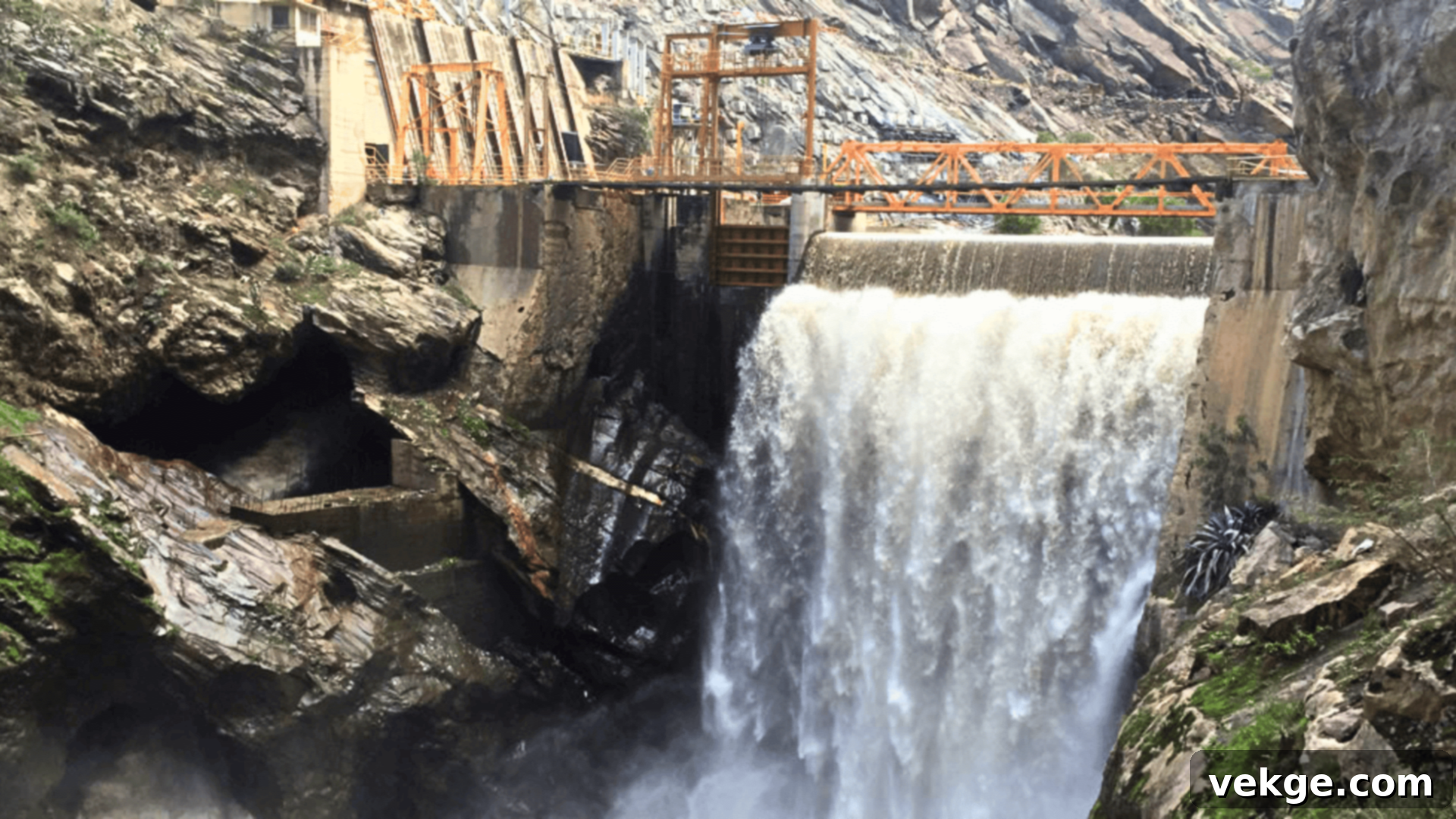
Overview: Cañón del Pato, or “Duck Canyon,” is a dramatic and narrow gorge situated in the Cordillera Blanca mountain range of the Peruvian Andes. This spectacular canyon is famed for its rugged, towering cliffs, the winding Santa River, and an impressive series of 35 tunnels carved through solid rock, making for an unforgettable and often thrilling passage.
Facts:
- Known for its unique series of hand-carved tunnels, which were originally built for a hydroelectric project and are now used by vehicles.
- The canyon features stunning and often precarious landscapes, with the road clinging to steep cliff faces.
- It is a popular destination for adventure travelers, cyclists, and photographers due to its dramatic scenery and challenging route.
- The Santa River flows powerfully through the canyon, adding to its natural beauty.
Why Visit: Cañón del Pato is a must-visit for adventure travelers and nature lovers seeking off-the-beaten-path experiences. Driving or cycling through its tunnels and along its narrow roads offers an adrenaline-pumping journey amidst breathtaking Andean scenery. It’s an exceptional place to capture dramatic photographs and appreciate the raw, untamed beauty of Peru’s highlands.
Interesting Fact: The canyon features one of the most beautiful and daring routes in the Andes, often considered a significant engineering marvel given the challenging terrain. The tunnels were constructed between 1913 and 1923 for a railway line, later adapted for road traffic.
18. Kuelap: The Fortress of the Cloud Warriors
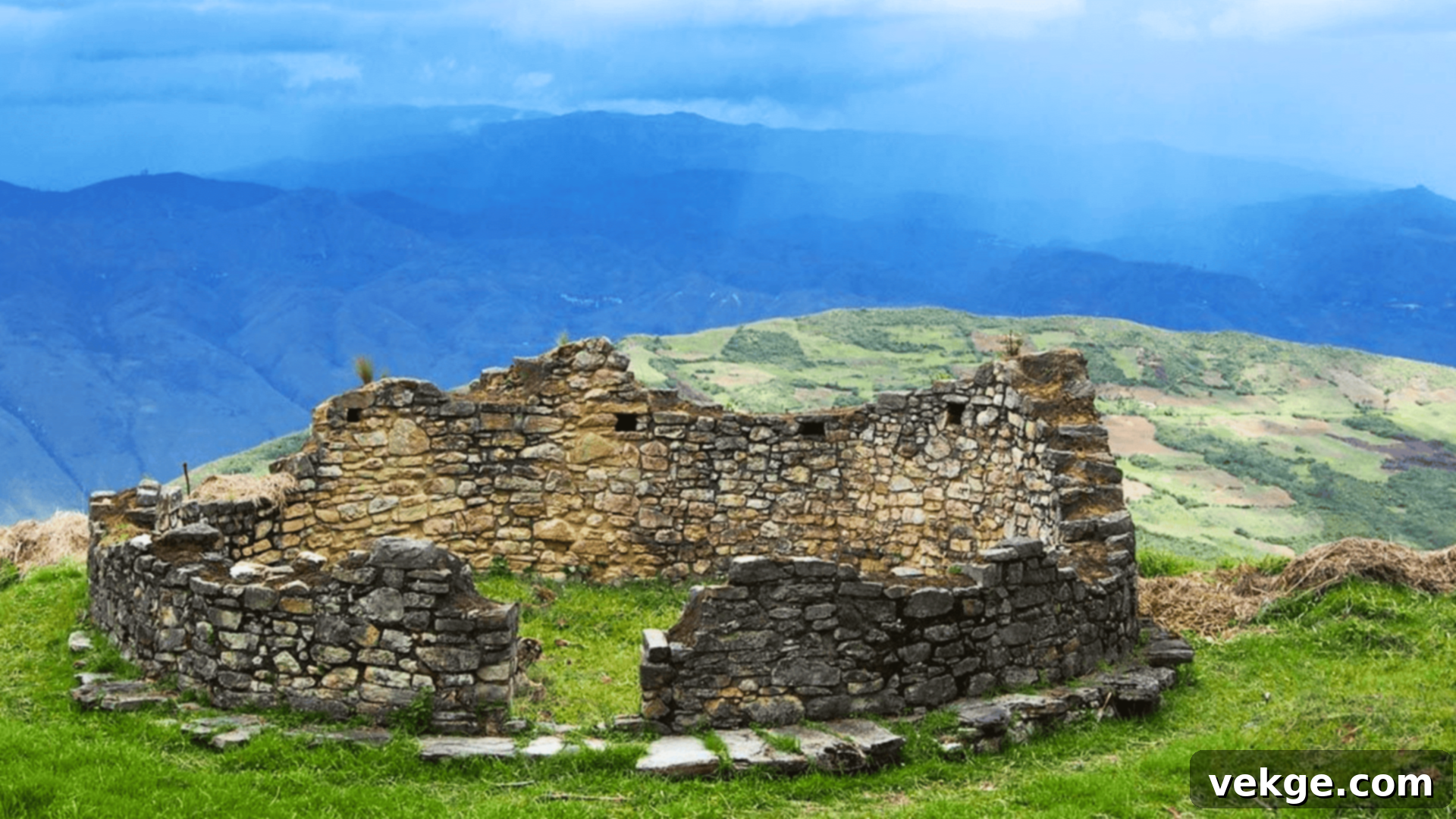
Overview: Kuelap is an imposing pre-Inca fortress, a walled city built by the Chachapoya people, often referred to as the “Warriors of the Clouds.” Located in the cloud forests of northern Peru, this archaeological site boasts massive stone walls, circular stone houses, and stunning panoramic views of the surrounding mountainous landscape, offering a glimpse into a powerful ancient civilization.
Facts:
- Located strategically in the cloud forest, providing both natural defenses and breathtaking panoramic views of the Utcubamba Valley.
- Known for its massive stone walls, some reaching up to 19 meters (62 feet) in height, and over 400 circular stone structures within.
- Pre-dates the Inca Empire, with construction believed to have begun around 800 AD.
- A modern cable car system now makes the site more accessible, offering spectacular views on the ascent.
Why Visit: Kuelap offers a magnificent historical site experience with significantly fewer tourists compared to more famous Inca ruins. It’s a chance to explore an ancient fortress of a unique pre-Inca culture, marvel at its impressive architecture, and enjoy the tranquility and stunning natural beauty of the cloud forest. It’s an ideal destination for those seeking adventure and a deeper dive into Peru’s diverse ancient history.
Interesting Fact: Kuelap was built by the Chachapoya people, an ancient Andean civilization famously known as the “Warriors of the Clouds.” They were skilled builders and warriors who controlled a vast territory in the high Amazonian Andes before their eventual conquest by the Inca Empire.
19. The Ballestas Islands: Peru’s Mini-Galapagos
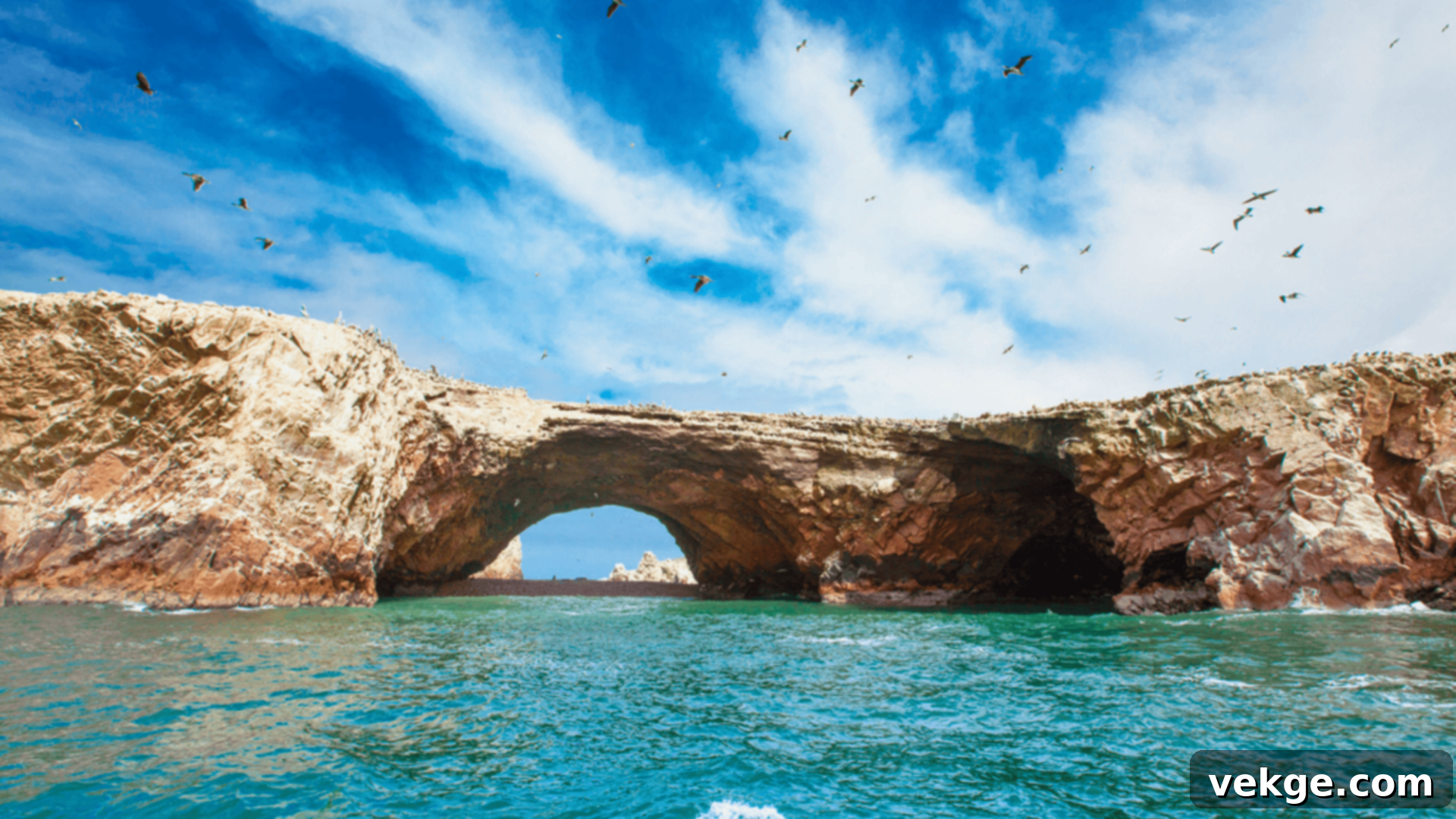
Overview: The Ballestas Islands are a collection of small, rocky islands off the coast of Paracas, often dubbed the “Poor Man’s Galapagos” due to their incredible biodiversity. These islands are a natural sanctuary for an astonishing array of marine wildlife, making them a prime destination for eco-tourism and wildlife observation in Peru.
Facts:
- Known for their large populations of sea lions, diverse species of seabirds (including guano birds), and Humboldt penguins.
- The islands are easily accessible by boat tours, which depart regularly from Paracas.
- The nutrient-rich Humboldt Current supports the abundant marine life around the islands.
- Bird guano, a valuable fertilizer, has been harvested from these islands for centuries.
Why Visit: Visiting the Ballestas Islands is an unforgettable experience for wildlife enthusiasts and nature photographers. A boat tour provides up-close views of countless sea lions basking on the rocks, enormous colonies of seabirds nesting on the cliffs, and the unique sight of penguins in their natural Pacific habitat. It’s a dynamic and vibrant ecosystem that truly feels like a miniature version of the famous Galapagos Islands.
Interesting Fact: The islands are indeed often called the “Poor Man’s Galapagos” because, despite their close proximity to the mainland, they host a remarkably diverse and accessible array of marine wildlife, offering an experience akin to the more distant and expensive Galapagos archipelago.
20. Tumbas de Sillustani: Ancient Burial Towers
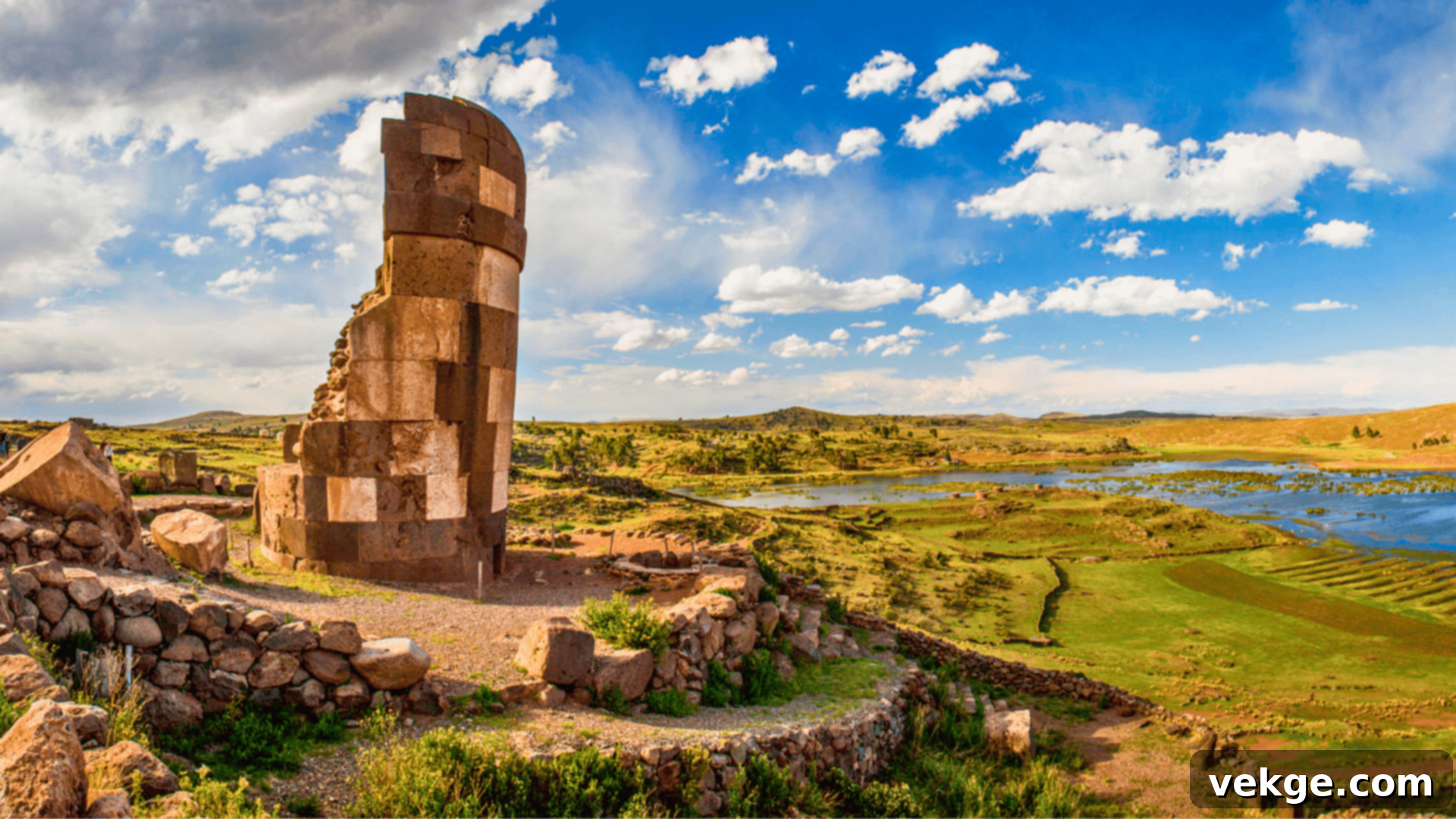
Overview: Tumbas de Sillustani is an impressive pre-Inca burial ground located near Puno, on a peninsula overlooking the beautiful Lake Umayo. This archaeological site is famous for its “chullpas,” tall, cylindrical stone burial towers, which were built by the Colla culture and later used by the Incas to inter their most important leaders and nobility.
Facts:
- Built predominantly by the Colla culture (a pre-Inca civilization) and later utilized by the Incas, these distinctive stone towers were used as elaborate burial chambers for important individuals.
- The site is set against the stunning, serene backdrop of Lake Umayo, enhancing its peaceful and mystical atmosphere.
- Some chullpas are nearly 12 meters (40 feet) tall and showcase sophisticated stonework.
- The structures are oriented to align with astronomical events, reflecting ancient cosmological beliefs.
Why Visit: Sillustani offers a peaceful and deeply historic site to visit near Lake Titicaca. It’s an opportunity to marvel at the impressive ancient funerary architecture, learn about pre-Inca cultures, and reflect on their beliefs about life and death, all while enjoying the tranquil beauty of the surrounding altiplano landscape and Lake Umayo. It’s a less strenuous and highly rewarding historical excursion.
Interesting Fact: The chullpas at Sillustani were not just tombs; they were elaborately designed monuments built to honor local leaders and ensure their transition to the afterlife. The most refined towers have perfectly fitted stones, echoing the skilled masonry often seen in Inca architecture, indicating a high level of craftsmanship and cultural exchange.
21. Caral: The Oldest City in the Americas
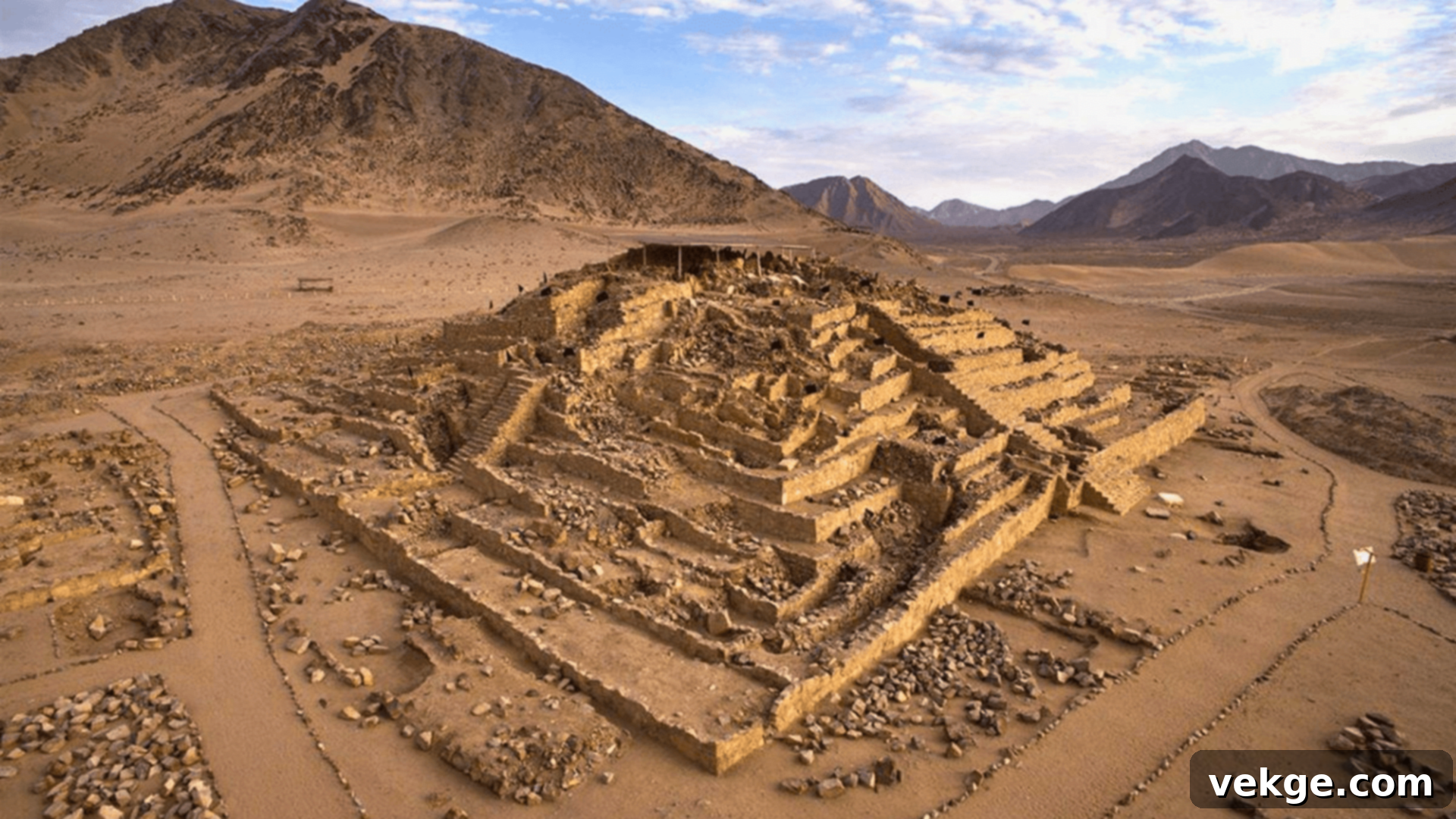
Overview: Caral, located in the Supe Valley north of Lima, is an extraordinary archaeological site recognized as the oldest known civilization in the Americas. Dating back over 5,000 years, this sprawling ancient city flourished contemporaneously with ancient Egypt and Mesopotamia, revealing a sophisticated urban center with impressive pyramids and ceremonial complexes.
Facts:
- It dates back over 5,000 years, making it the oldest known urban center in the Americas.
- Features six large pyramid-like structures, circular plazas, and various ceremonial areas, indicating a highly organized society.
- The Caral civilization is notable for having developed without evidence of warfare, relying on commerce and culture.
- Discovered in 1997, it revolutionized understanding of pre-Columbian history in the Americas.
Why Visit: A visit to Caral is a journey back in time to the very dawn of urban civilization in the Americas. Explore its ancient pyramids and public plazas, gaining a profound understanding of one of history’s earliest and most influential urban centers. It’s a truly humbling experience to walk through a city that stood thousands of years before the Incas, revealing the incredible depth of Peru’s historical legacy.
Interesting Fact: Caral was officially declared a UNESCO World Heritage site in 2009. What’s even more fascinating is the discovery of musical instruments and quipus (knotted textile devices used for record-keeping) at the site, suggesting a highly developed culture that prioritized peace and intellectual pursuits rather than military might.
22. Maras Salt Mines: Terraced Salt Ponds
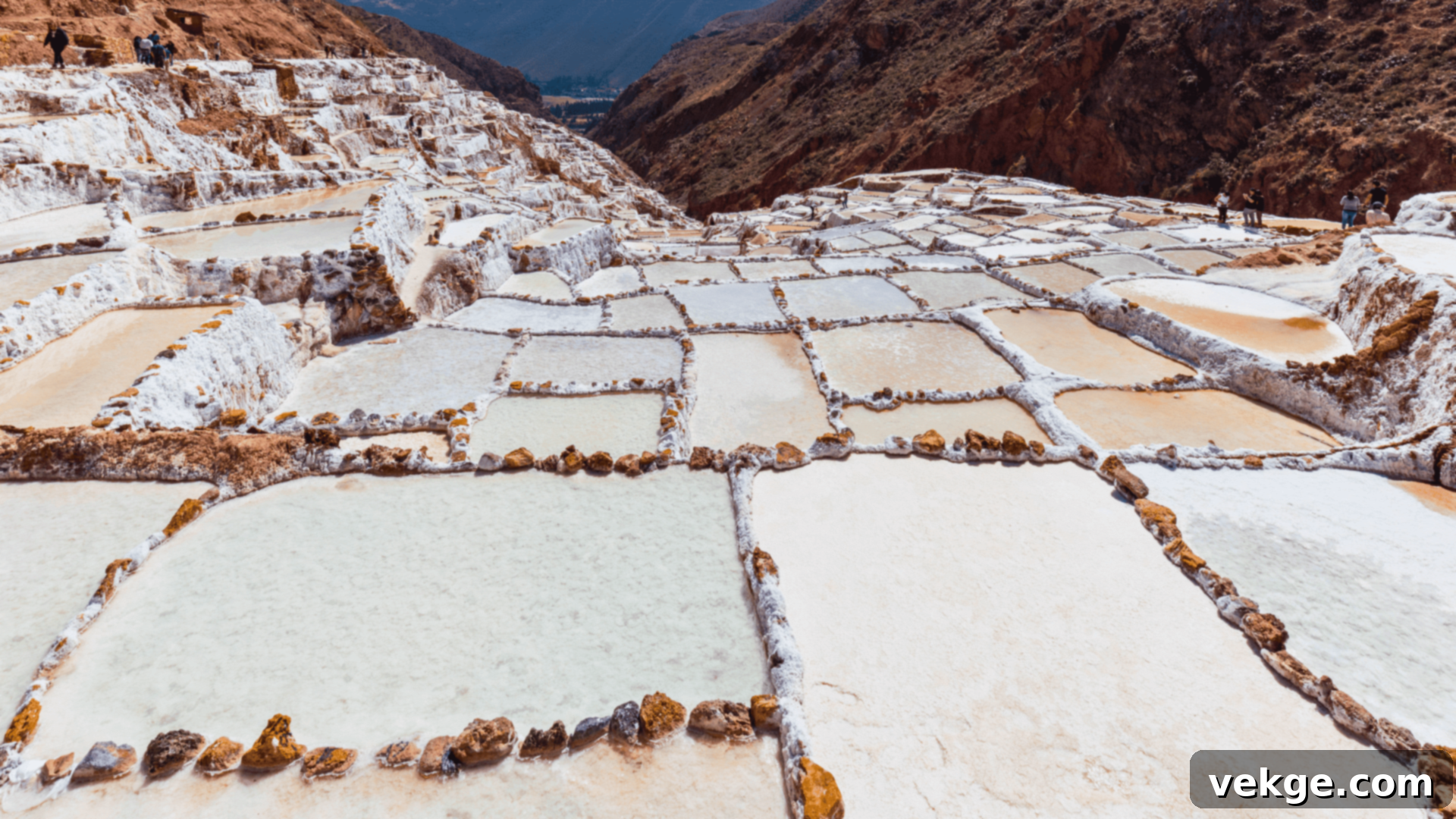
Overview: The Maras Salt Mines, or Salineras de Maras, are an astonishing sight in the Sacred Valley, consisting of thousands of ancient terraced salt ponds cascading down a hillside. This intricate system of salt evaporation ponds has been continuously in use since pre-Inca times, providing a unique glimpse into traditional salt harvesting methods and creating a breathtaking, otherworldly landscape.
Facts:
- Located picturesquely in the Sacred Valley, not far from the Inca site of Moray.
- The salt is harvested through a meticulous process of evaporating water from a natural underground saline spring, which flows into small, shallow ponds.
- There are over 3,000 individual salt pans, each owned and operated by local families.
- The salt produced here is known for its unique pink hue and rich mineral content.
Why Visit: The Maras Salt Mines offer a truly striking and unique landscape that is both visually captivating and historically rich. Witness the dazzling white salt ponds gleaming under the sun, learn about the ancient techniques still employed by local communities, and appreciate the ingenuity behind this traditional industry. It’s an excellent photographic opportunity and a fascinating cultural experience.
Interesting Fact: The salt mines have been continuously utilized since Inca times, and potentially even earlier, by various pre-Inca cultures. The communal ownership and traditional harvesting methods have been passed down through generations, making it a living heritage site that sustains local communities to this day.
23. Vinicunca (Rainbow Mountain): A Geological Marvel
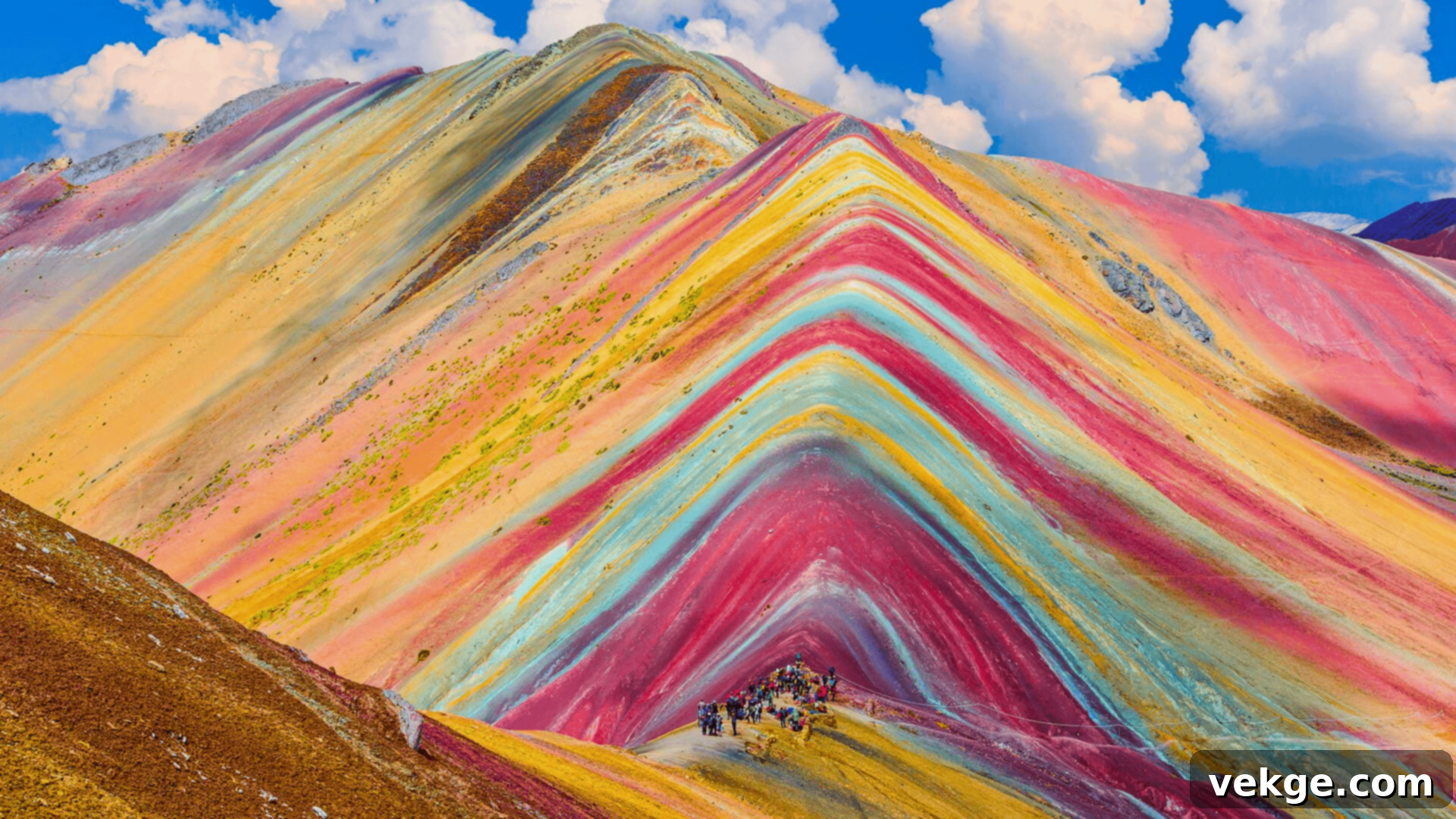
Overview: Vinicunca, more famously known as Rainbow Mountain, is a geological wonder nestled deep in the Peruvian Andes. This breathtaking mountain is renowned for its vibrant, naturally occurring stripes of red, yellow, green, and purple, formed by millions of years of mineral deposits. It has rapidly become one of Peru’s most iconic and sought-after trekking destinations.
Facts:
- Famous for its incredibly vibrant, distinct layers of red, yellow, green, turquoise, and purple slopes, creating a rainbow effect.
- It has become a highly popular trekking destination in the Cuzco region, attracting adventurers from around the globe.
- Located at an astounding altitude of over 5,200 meters (17,060 feet) above sea level, requiring careful acclimatization.
- The colors are a result of weathering and mineralogy, including red sandstone, yellow limonite, and green chlorite.
Why Visit: Vinicunca offers the chance to witness one of the most unique and visually stunning landscapes in the world. The challenging trek to reach its summit is incredibly rewarding, providing unparalleled panoramic views of the multicolored mountain and the surrounding snow-capped Andean peaks. It’s an unforgettable experience for hikers and nature lovers alike, showcasing Peru’s incredible geological diversity.
Interesting Fact: The mountain’s striking colors are a result of complex geological processes and mineral deposits that occurred over millions of years. It was only relatively recently (around 2015) that the mountain’s snow cover melted sufficiently to reveal its spectacular hues, leading to its rapid rise in popularity.
24. Huaca Pucllana: An Ancient Pyramid in Lima
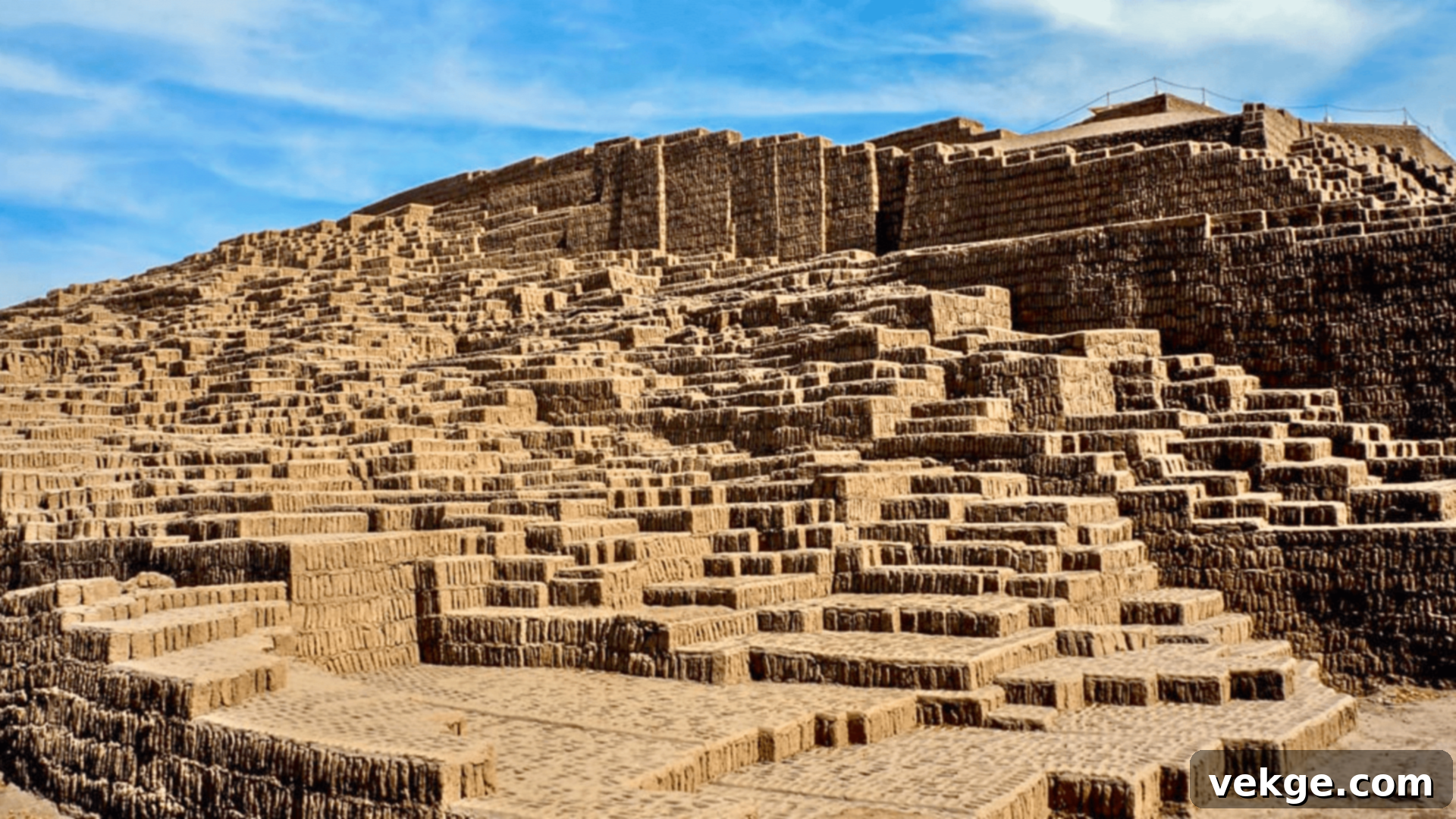
Overview: Huaca Pucllana is a remarkable archaeological site located surprisingly in the heart of Miraflores, one of Lima’s most modern districts. This ancient pyramid, constructed from adobe bricks, was built by the Lima culture between 200 and 700 AD and served as a significant administrative and ceremonial center, contrasting sharply with the urban sprawl around it.
Facts:
- An ancient pyramid and complex built predominantly from adobe (mud) bricks by the Lima culture.
- It was used for ceremonial purposes, including rituals, offerings, and burials.
- The site includes a museum and allows visitors to explore the pyramid and learn about the ancient culture that built it.
- The distinct “book-like” arrangement of its adobe bricks is a unique architectural feature.
Why Visit: Huaca Pucllana offers a fascinating glimpse into Lima’s pre-Inca history without having to leave the city. Explore this impressive adobe pyramid, learn about the Lima culture and their practices, and appreciate how ancient civilizations thrived in what is now a bustling metropolis. It’s an accessible and intriguing historical site that provides a different perspective on Peru’s rich past.
Interesting Fact: The pyramid was built using millions of adobe bricks, a common and durable building material for the Lima people. These bricks were often placed vertically, resembling books on a shelf, a technique believed to offer greater resistance to earthquakes, a testament to ancient engineering in a seismic zone.
25. The Inca Trail: Legendary Trek to Machu Picchu
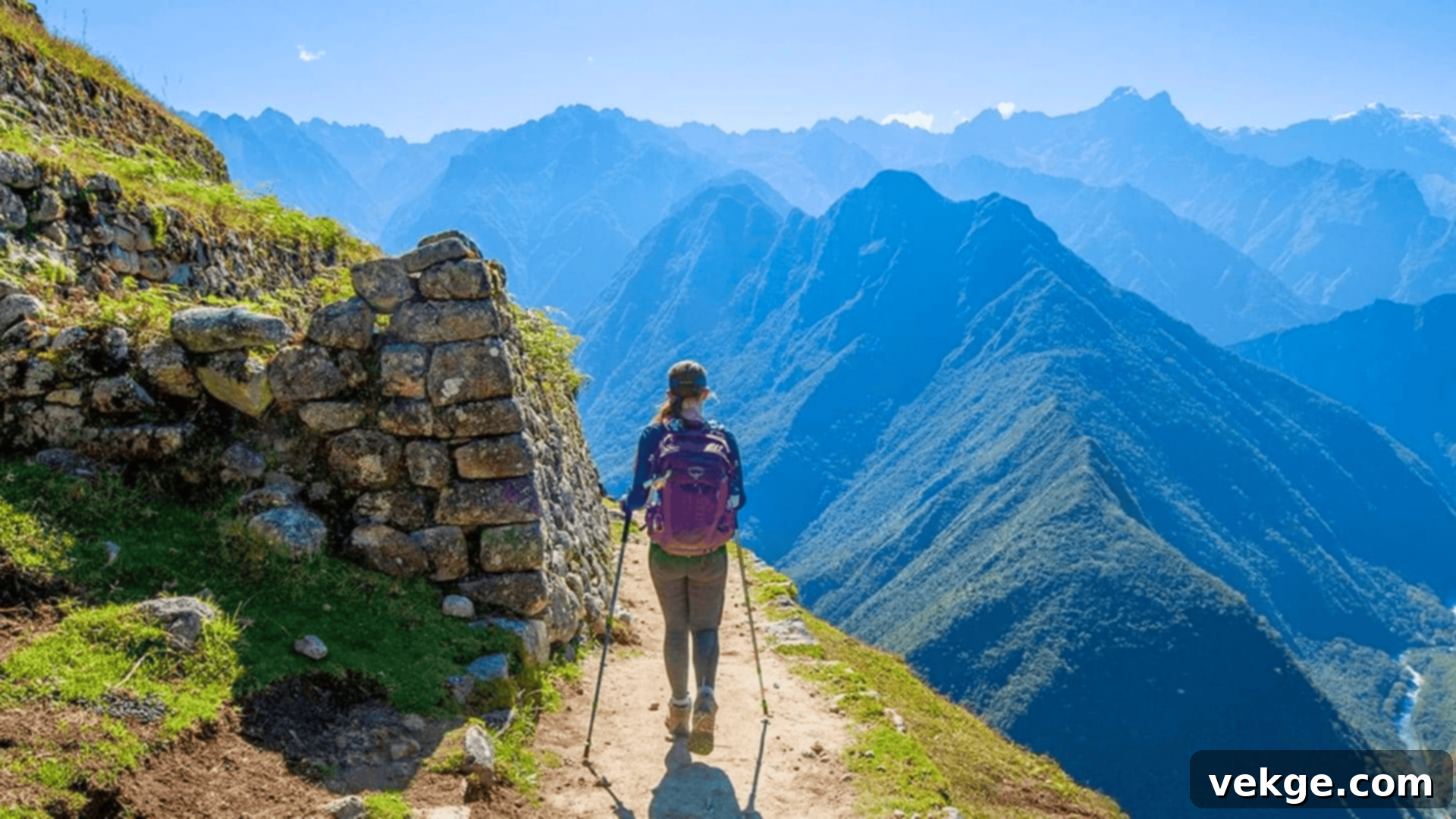
Overview: The Inca Trail is undoubtedly the most famous and iconic hiking route in South America, culminating in a dramatic arrival at the magnificent Machu Picchu. This ancient network of trails, originally built by the Incas, traverses breathtaking Andean landscapes, cloud forests, and a succession of smaller Inca ruins, offering an unparalleled journey through history and nature.
Facts:
- The classic Inca Trail is typically a 4-day, 3-night trek that passes through diverse ecosystems, from high mountain passes to lush cloud forests, and numerous archaeological sites.
- It is one of the most popular and regulated trekking routes in the world, with daily permits strictly limited to preserve the trail.
- The trail follows sections of the vast Inca road system (Qhapaq Ñan).
- Highlights include Dead Woman’s Pass (Warmiwañusqa) and the stunning Sun Gate (Inti Punku) entry to Machu Picchu.
Why Visit: The Inca Trail is the ultimate adventure for history and nature lovers, offering a challenging yet incredibly rewarding experience. Trekking this ancient path provides not only stunning scenery and a profound physical accomplishment but also a unique historical pilgrimage, following in the footsteps of the Incas themselves. The dramatic reveal of Machu Picchu from the Sun Gate is an emotional and unforgettable culmination.
Interesting Fact: The Inca Trail is renowned not only for its historical significance but also for the amazing views it offers, culminating in the iconic first glimpse of Machu Picchu at dawn from the Sun Gate. This perspective reveals the citadel nestled perfectly amidst the surrounding mountains, a truly magical moment for every hiker.
26. La Catedral (Cuzco): A Masterpiece of Colonial Art
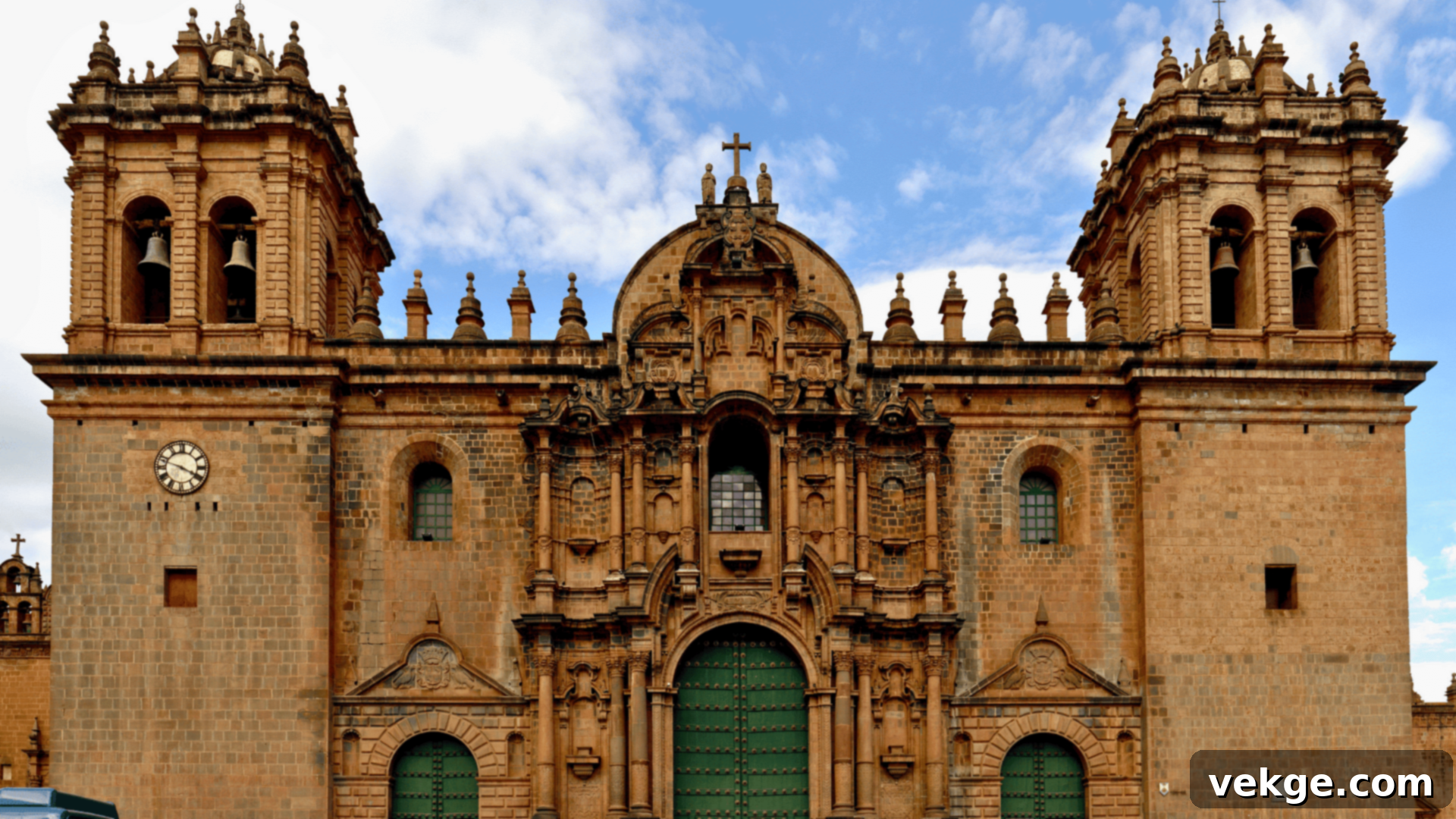
Overview: La Catedral de la Asunción, commonly known as Cuzco Cathedral, is a magnificent basilica located in the heart of Cuzco’s Plaza de Armas. This imposing structure, built over nearly a century, stands as a prime example of Spanish colonial architecture and artistry, skillfully incorporating elements of Inca masonry from the Viracocha palace it replaced.
Facts:
- It was built by the Spanish on top of the foundations of the Qorikancha, the Inca temple of Viracocha, symbolizing the triumph of Christianity over Inca religion. (Correction: It was built on the foundations of Kiswarkancha, the palace of Viracocha, NOT Qorikancha, which is nearby).
- Known for its grand colonial architecture, a mix of Gothic-Renaissance and Baroque styles, and its vast collection of fine art, including works from the Cuzco School.
- The construction of the cathedral took almost 100 years, beginning in 1560 and largely completed by 1654.
- Houses a famous painting of “The Last Supper” depicting a guinea pig, a local delicacy, as the main course.
Why Visit: The Cuzco Cathedral is a vital cultural and religious landmark, offering a profound insight into the colonial period and the fusion of cultures in Peru. Explore its stunning chapels, admire the intricate altars, and discover a remarkable collection of colonial paintings and sculptures, many of which depict indigenous figures and Andean landscapes, providing a unique artistic and historical experience.
Interesting Fact: The cathedral houses a unique blend of Spanish colonial and indigenous Inca art, particularly evident in the “Cuzco School” paintings. These artworks often feature Christian themes but incorporate Andean elements, colors, and indigenous faces, reflecting the cultural syncretism of the period.
27. Raqch’i: The Temple of Wiracocha
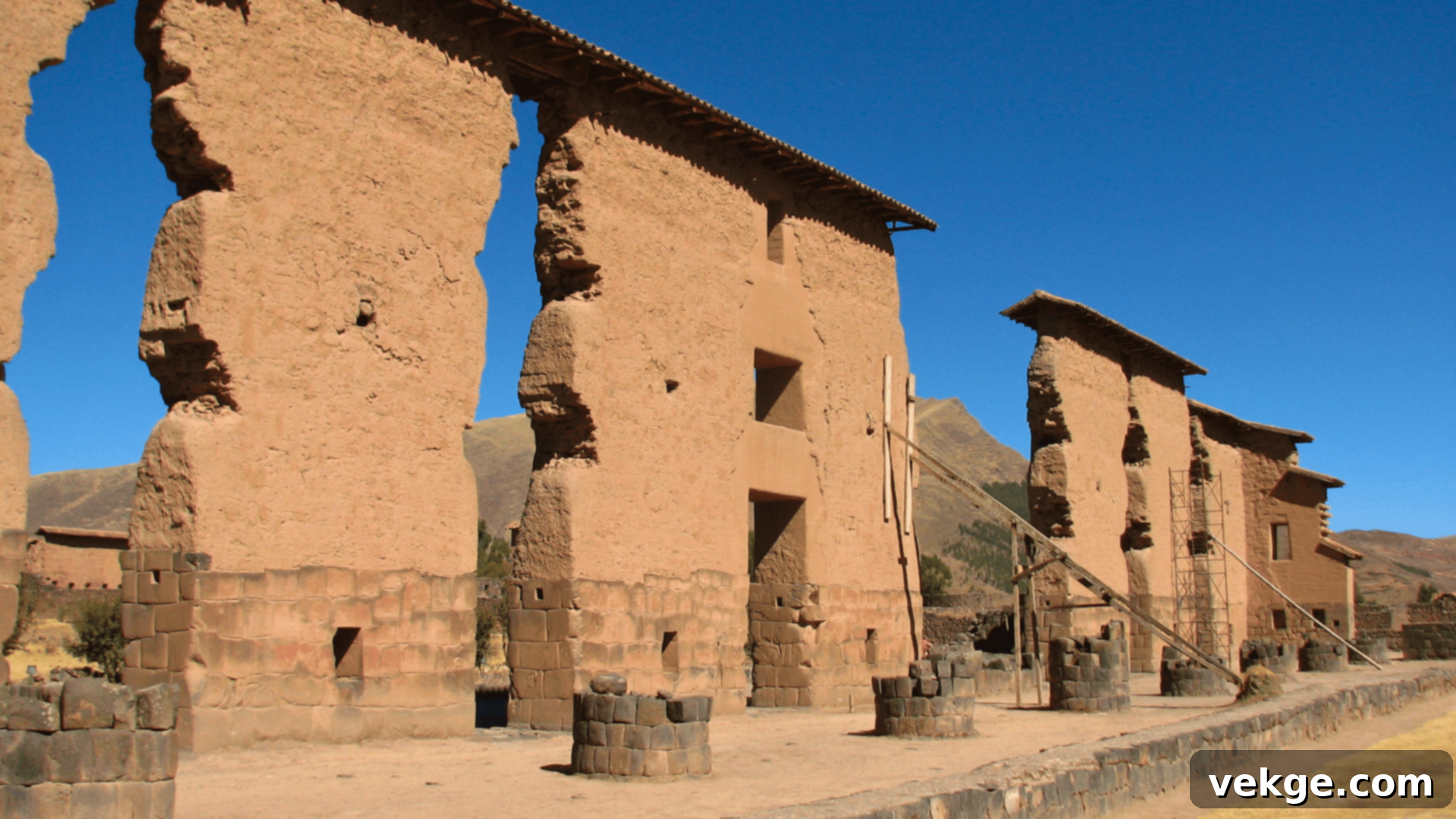
Overview: Raqch’i is a large and historically significant Inca archaeological site located in the southern Cuzco region of Peru. It is most famous for its colossal Temple of Wiracocha, an extraordinary structure dedicated to the principal creator deity in the Incan religion, showcasing unique architectural styles and massive scale.
Facts:
- It is known for its impressive Temple of Wiracocha, a massive rectangular building featuring a central adobe wall over 12 meters high, flanked by stone columns, a unique feature in Inca architecture.
- The site includes numerous well-preserved ruins, such as Inca living quarters, storehouses (qollqas), and ceremonial baths, surrounded by vast agricultural terraces.
- Raqch’i served as an important religious, administrative, and military center along the Inca road system.
- The site features volcanic stone foundations combined with adobe walls.
Why Visit: Raqch’i offers a fascinating example of Inca architecture and religious devotion on a grand scale. Explore the unique Temple of Wiracocha, marvel at the vast storehouses that once held sustenance for the empire, and gain insight into the daily life of an important Inca outpost. It’s a less frequented site that provides a deeper understanding of Inca societal organization and spiritual beliefs.
Interesting Fact: Raqch’i is widely believed to have been a major religious and ceremonial center dedicated to Wiracocha, the creator god of the Inca pantheon. The sheer size and distinctive architecture of its temple underscore its importance in the Inca spiritual landscape and its role as a pilgrimage site.
28. Cantalloc Aqueducts: Ancient Nazca Engineering
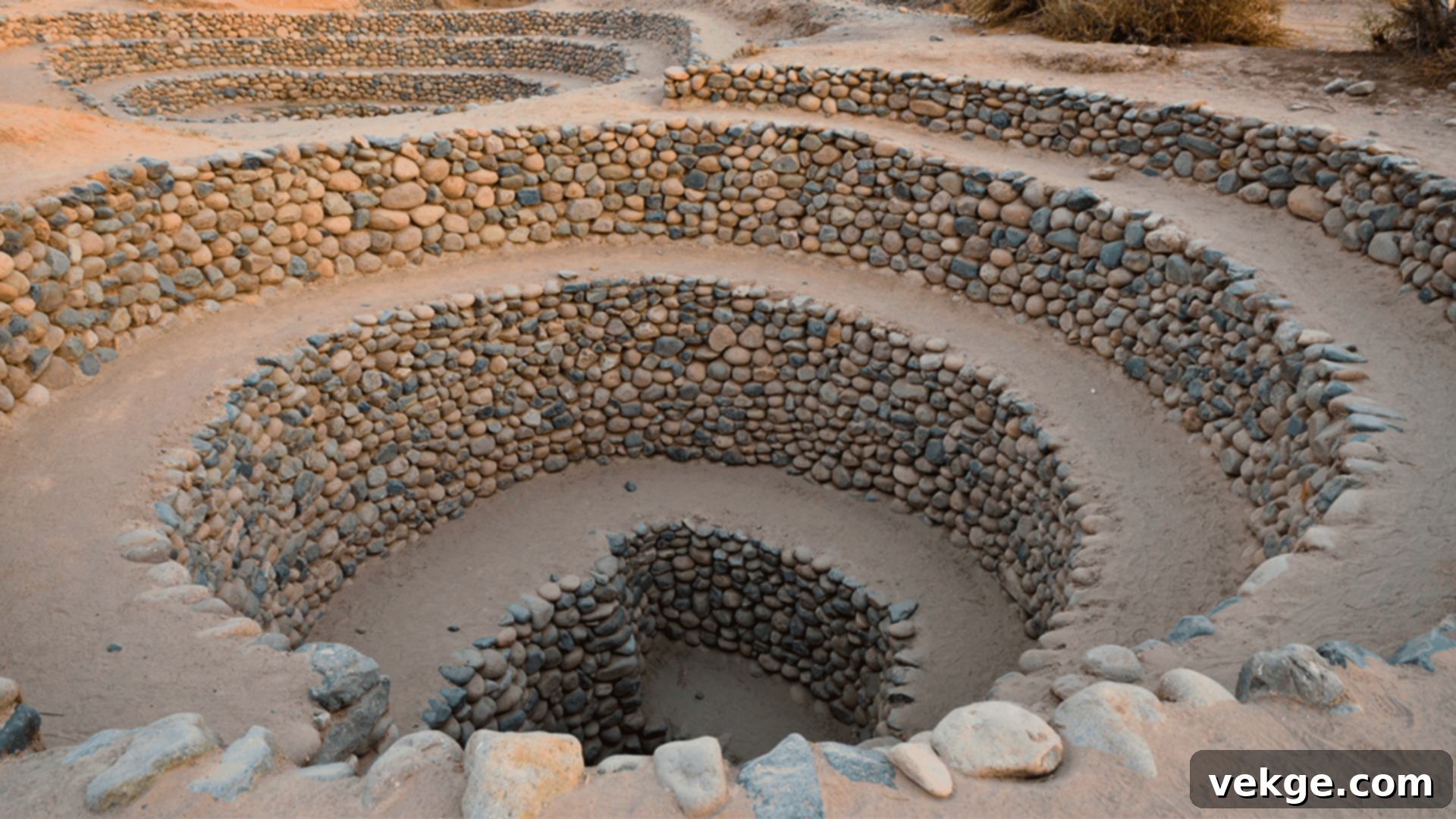
Overview: The Cantalloc Aqueducts are an ingenious system of ancient underground water channels and wells, built by the Nazca culture over 1,500 years ago in the arid Nazca region of Peru. This remarkable feat of engineering allowed the Nazca people to irrigate their desert lands, sustaining agriculture and their civilization in an otherwise inhospitable environment.
Facts:
- Features a sophisticated network of underground channels and spiral-shaped wells (puquios) designed to tap into subterranean water sources and bring water to the surface.
- A marvel of ancient hydraulic engineering, demonstrating the Nazca’s profound understanding of their environment and innovative problem-solving.
- The puquios allowed for access to the water table and facilitated maintenance of the channels.
- Many of these aqueducts are still functional today, providing water to local farmers.
Why Visit: The Cantalloc Aqueducts offer a tangible connection to the advanced engineering capabilities of the ancient Nazca culture. Explore these remarkable structures and marvel at how a civilization in one of Peru’s most arid regions managed to sustain itself through such innovative water management. It’s a testament to human ingenuity and an intriguing historical site.
Interesting Fact: Perhaps most impressively, many of the Cantalloc Aqueducts are still functional today, over 1,500 years after their construction, continuing to provide a vital water supply to the Nazca region. This enduring legacy highlights the incredible durability and effectiveness of Nazca engineering.
29. Sillar Route: The Heart of Arequipa’s Architecture
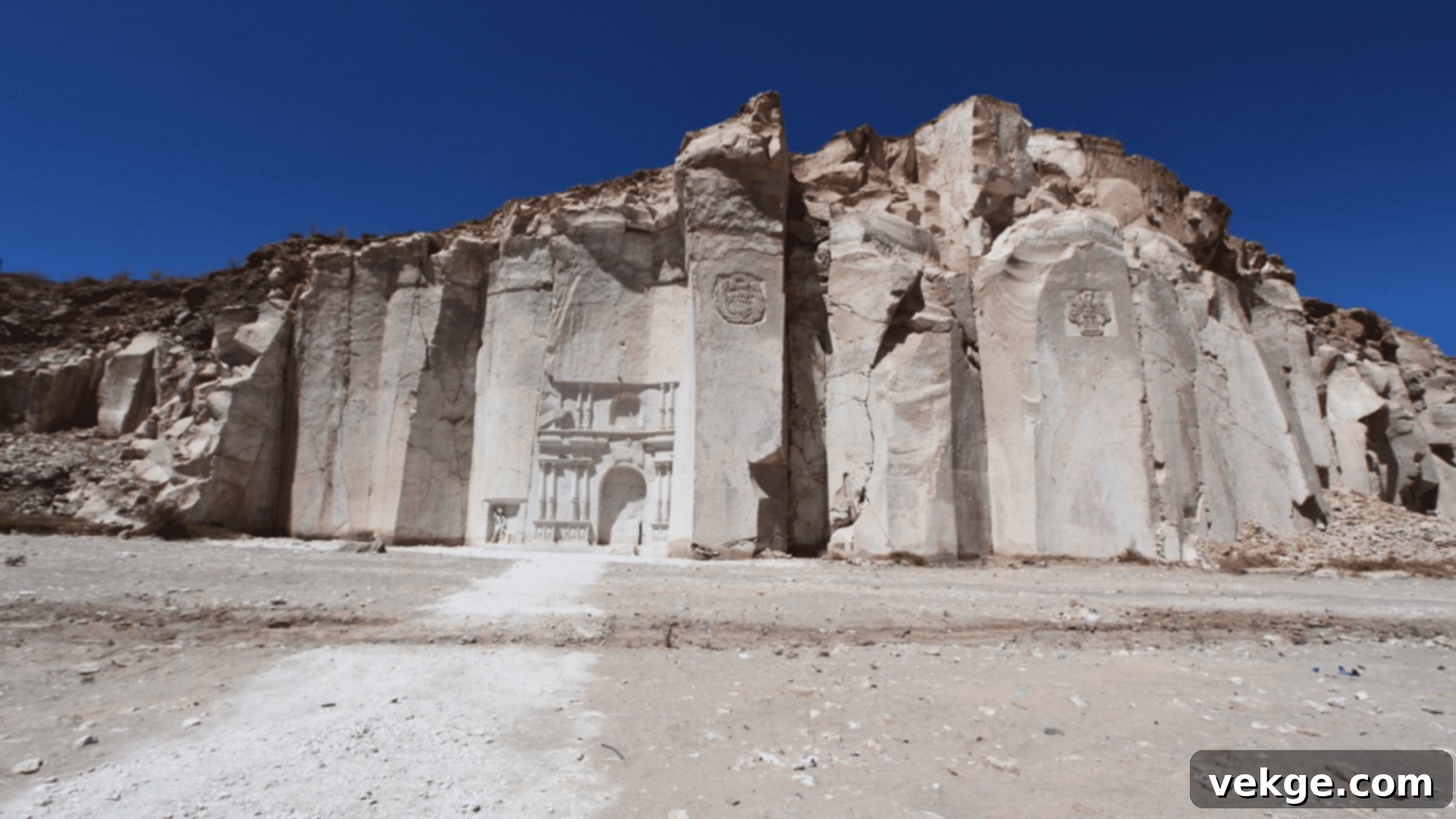
Overview: The Sillar Route is a captivating excursion in the Arequipa region that takes visitors to the quarries where the gleaming white volcanic rock, known as sillar, is extracted. This unique route offers insight into the geological origins of Arequipa’s iconic architecture and showcases the traditional methods used to quarry and carve this distinctive building material.
Facts:
- The Sillar quarries are the primary source of the unique white volcanic stone used extensively in the construction of Arequipa’s colonial buildings.
- Visitors can embark on guided tours of the working quarries, witnessing skilled artisans carving sillar and enjoying the striking pale landscape.
- The route provides opportunities to see impressive sillar formations carved by nature and human hands.
- It offers insights into the geological processes that formed the region’s volcanoes and the resulting sillar deposits.
Why Visit: The Sillar Route provides a unique opportunity to understand the architectural heritage of Arequipa, “The White City,” firsthand. See how the stunning white stone is extracted and sculpted, and learn about the traditional craftsmanship involved. Beyond the cultural insight, the landscape of the quarries themselves is incredibly picturesque, offering fantastic photo opportunities and a memorable experience.
Interesting Fact: The volcanic stone, sillar, found along this route is directly responsible for giving Arequipa its famous nickname, “The White City.” Its light color and relative softness make it an ideal building material, allowing for the intricate carvings and beautiful facades that define the city’s UNESCO World Heritage historic center.
30. Pachacamac: Ancient Pilgrimage Site Near Lima
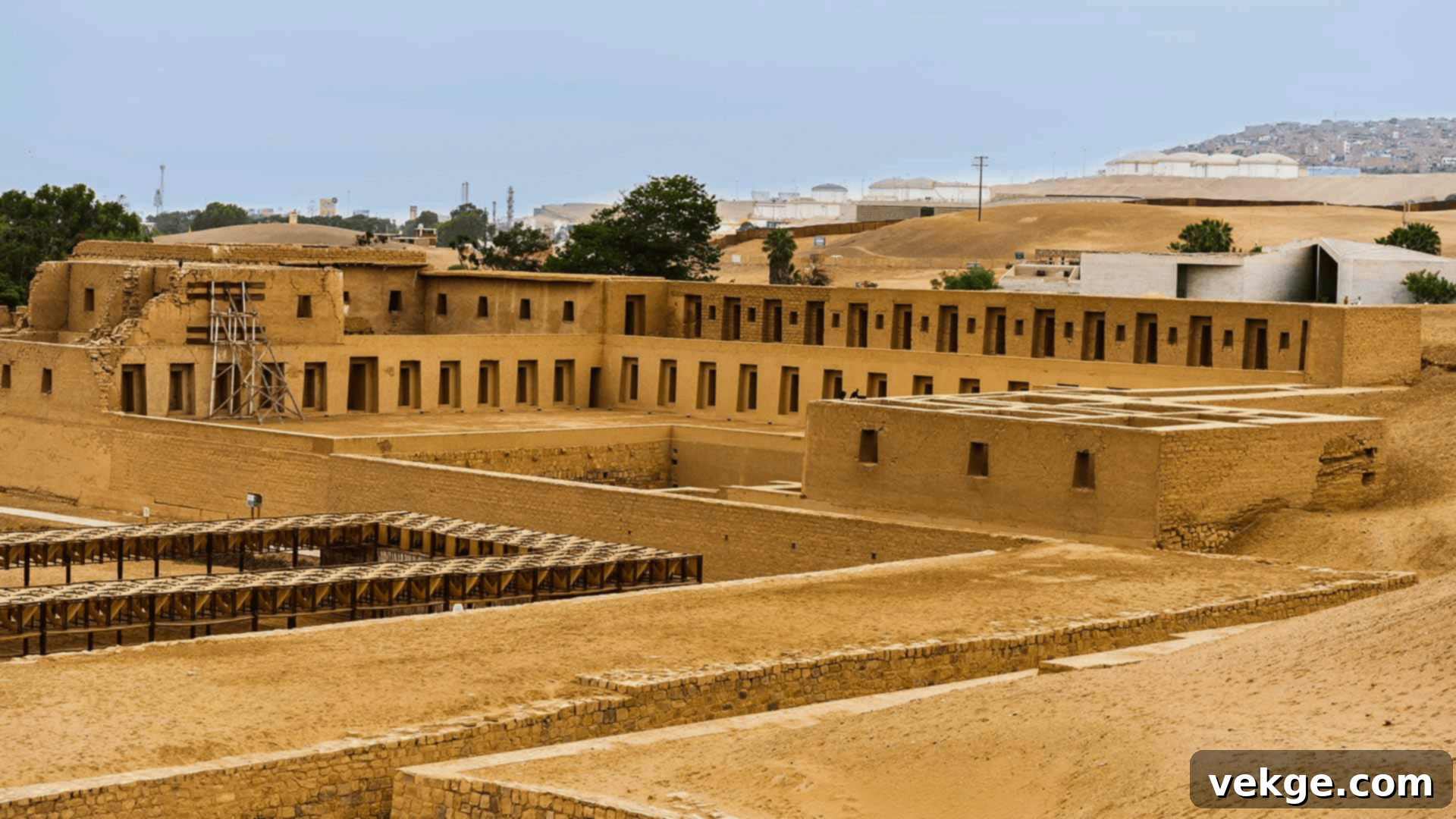
Overview: Pachacamac is a vast and historically significant pre-Columbian archaeological site located just south of Lima. For over 1,500 years, it served as one of the most important religious and administrative centers on the Peruvian coast, attracting pilgrims from across the Andes. The site features numerous pyramids, temples, and plazas built by various cultures, including the Lima, Wari, Ichma, and Inca.
Facts:
- It served as an extremely important religious and ceremonial center for various pre-Inca cultures (Lima, Wari, Ichma) and later for the Inca Empire.
- Known for its impressive adobe pyramids, temples, and palaces, many of which still stand today, offering a comprehensive view of ancient coastal architecture.
- The site includes a well-regarded museum that displays artifacts unearthed from the excavations.
- Dedicated to Pachacamac, the earthquake god, and a creator deity.
Why Visit: Pachacamac offers a profound site of historical significance and spiritual power just outside of Peru’s capital. Explore its sprawling complex of adobe structures, learn about the successive civilizations that worshipped here, and appreciate its role as a major pilgrimage destination in ancient Peru. It’s an ideal day trip from Lima for those interested in pre-Inca history.
Interesting Fact: Pachacamac was one of the most important pilgrimage centers for ancient Peruvians, comparable in spiritual significance to what Mecca is for Muslims or Jerusalem for Christians. People traveled from far and wide across the Andes to worship the god Pachacamac and seek counsel from his oracle.
31. Iquitos: Gateway to the Amazon River
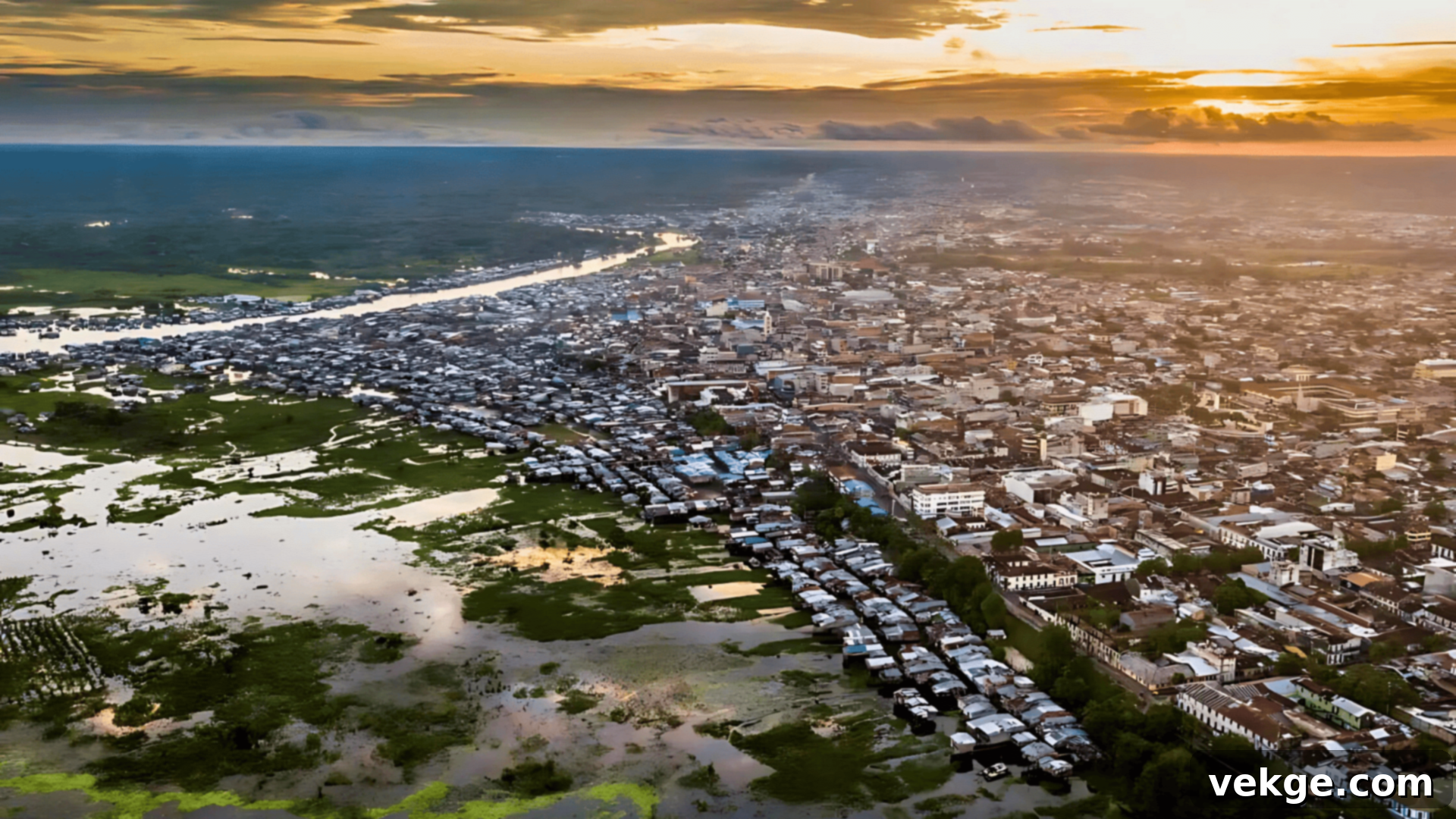
Overview: Iquitos is a vibrant and unique city located deep within the Peruvian Amazon Rainforest, serving as the world’s largest city that is not accessible by road. Its remote location means it is primarily reached by boat along the Amazon River or by air, making it an extraordinary gateway for exploring the vast biodiversity and indigenous cultures of the Peruvian Amazon.
Facts:
- It is known for its unparalleled proximity to the mighty Amazon River and its extensive eco-tourism opportunities, including jungle lodges and river cruises.
- A bustling port city, it acts as the primary gateway for expeditions into the northern Peruvian Amazon rainforest.
- Features unique architecture from the rubber boom era, including the Iron House designed by Gustave Eiffel.
- The Belén Market, a floating market, offers an incredible cultural experience.
Why Visit: Iquitos provides a thrilling starting point for an Amazon adventure, offering a vibrant city experience combined with easy access to the unparalleled wilderness of the rainforest. Explore its lively markets, unique architecture, and embark on jungle excursions to spot exotic wildlife, visit indigenous communities, and cruise the legendary Amazon River. It’s an essential destination for anyone seeking a deep dive into the Amazon’s heart.
Interesting Fact: Iquitos holds the unique distinction of being the largest city in the world that cannot be reached by road. Its isolation has fostered a distinct culture and lifestyle, making it a truly fascinating urban center amidst the vastness of the Amazon jungle.
32. Chachapoyas: Adventure in the Cloud Forest
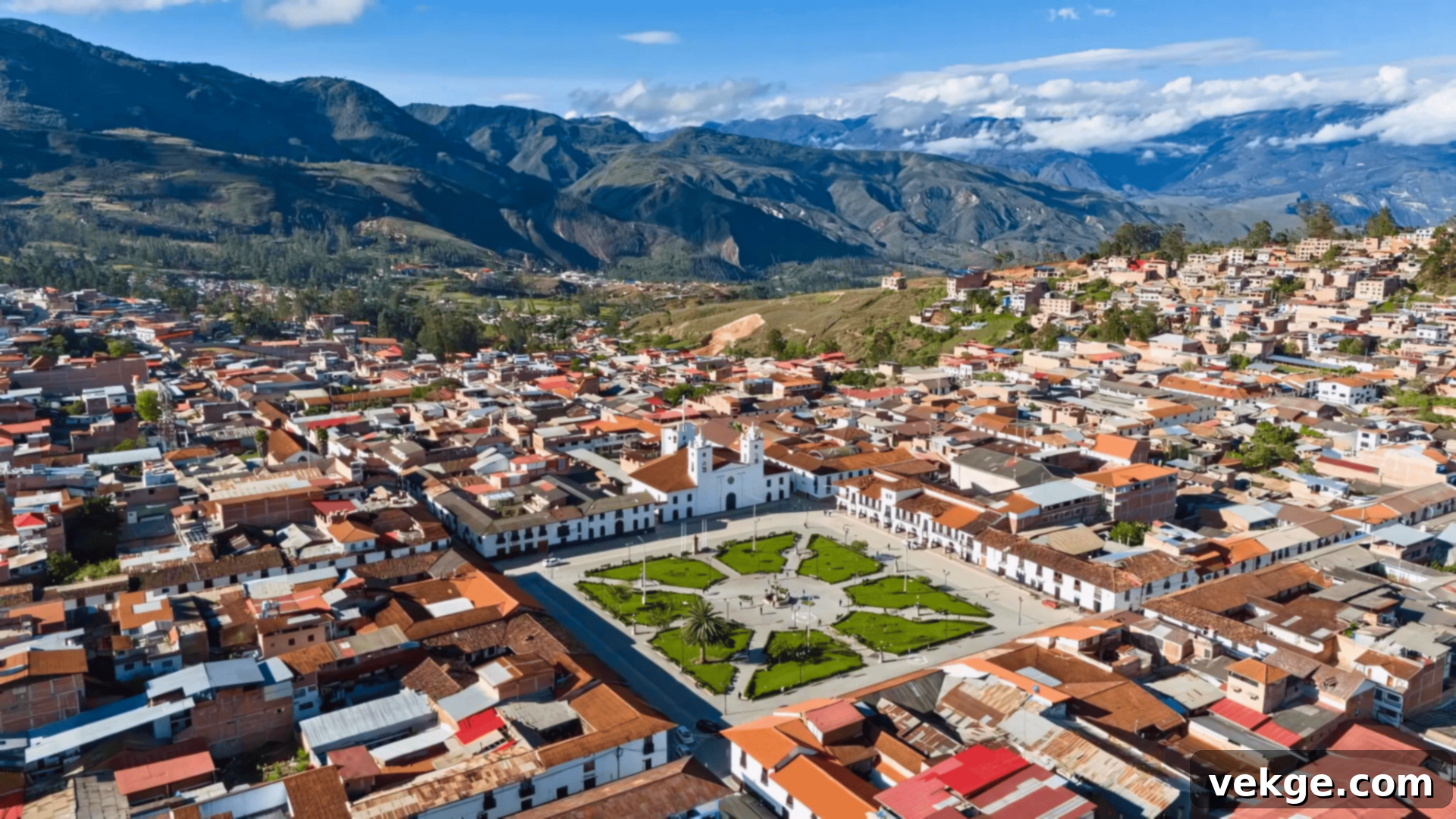
Overview: Chachapoyas is a charming colonial town nestled in the remote cloud forests of northern Peru, serving as a tranquil base for exploring an incredible array of ancient ruins and natural wonders. This region is a treasure trove of pre-Inca history, particularly associated with the “Warriors of the Clouds” – the Chachapoya culture.
Facts:
- It is the gateway to significant archaeological sites, most notably the colossal Kuelap fortress and the sarcophagi of Karajía.
- The town is surrounded by lush, green landscapes, deep canyons, and spectacular waterfalls, including Gocta Waterfall, one of the world’s tallest.
- Chachapoyas offers a more authentic and less crowded travel experience compared to the southern circuit.
- The region is ideal for trekking, birdwatching, and cultural immersion.
Why Visit: Chachapoyas is an ideal destination for history lovers and nature enthusiasts seeking off-the-beaten-path adventures. Explore the magnificent Kuelap fortress, discover unique burial sites, and hike to the breathtaking Gocta Waterfall. The region offers a rich blend of ancient culture, stunning cloud forest scenery, and a tranquil atmosphere away from mass tourism.
Interesting Fact: The Chachapoya people, often referred to as the “Warriors of the Clouds,” were a sophisticated and fierce civilization who built impressive stone fortresses like Kuelap and created unique forms of burial, such as sarcophagi clinging to cliff faces. Their culture flourished in the high Andean Amazon before the Inca conquest.
33. Huayna Picchu: The Peak Above Machu Picchu
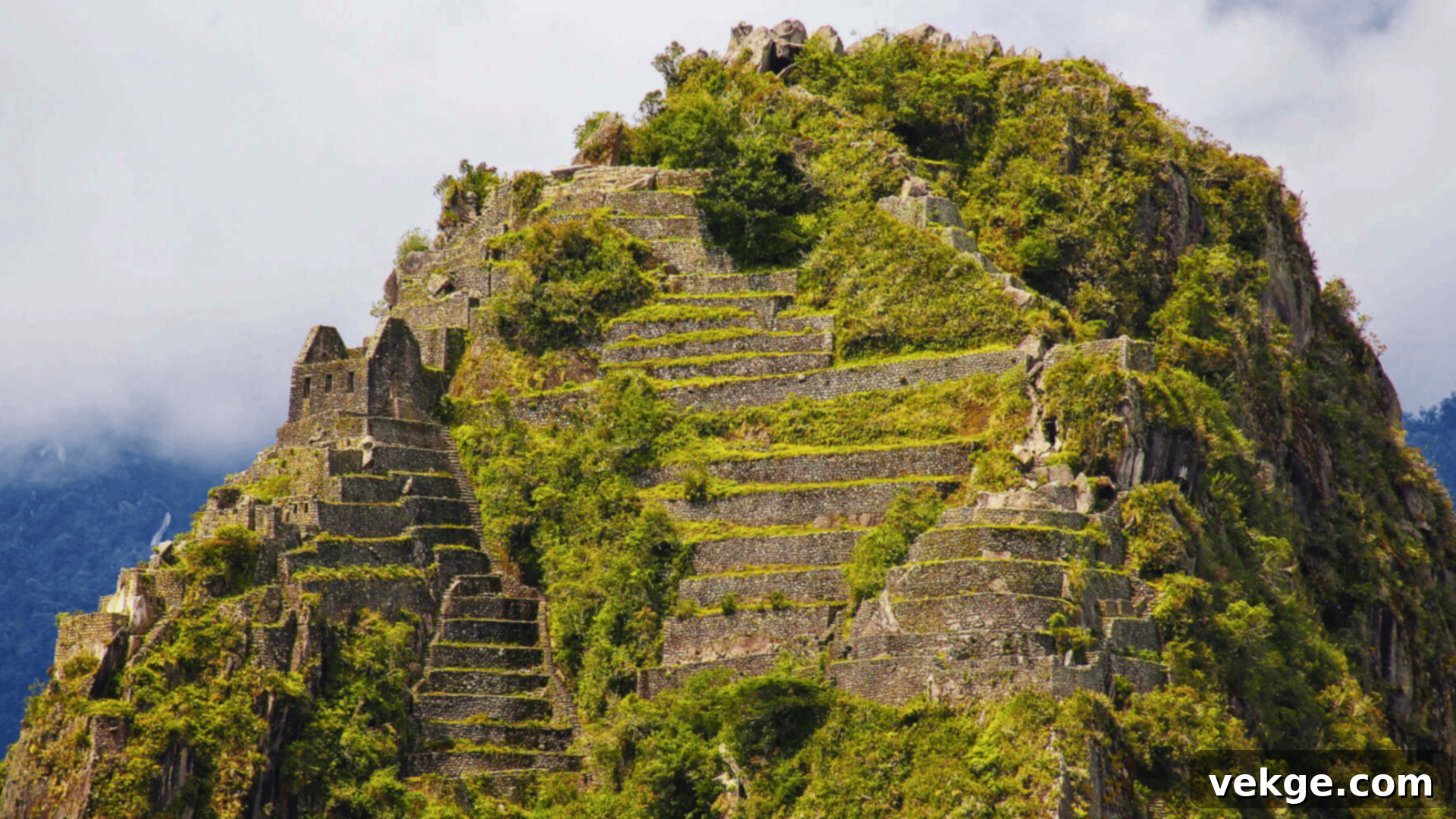
Overview: Huayna Picchu is the distinctive, pyramid-shaped mountain that dramatically rises behind the main citadel of Machu Picchu, an iconic feature in countless photographs of the ancient city. Climbing this peak offers an exhilarating and challenging experience, rewarding trekkers with unparalleled aerial views of Machu Picchu itself and the surrounding Urubamba River valley.
Facts:
- It is extremely popular for hikers seeking an elevated and unique perspective of the Machu Picchu ruins from above.
- The hike is known for being steep and sometimes precarious, but incredibly rewarding with its panoramic views.
- Inca ruins, including the Temple of the Moon, are found on its slopes.
- Access to Huayna Picchu is highly restricted, with only a limited number of permits issued daily to preserve the site and ensure safety.
Why Visit: For those seeking an extra challenge and an even more spectacular vantage point, climbing Huayna Picchu is a must-do. The steep ascent leads to breathtaking panoramic views of Machu Picchu, revealing the intricate layout of the citadel against the dramatic backdrop of the Andes. It’s a truly fantastic and memorable addition to any visit to the Inca masterpiece.
Interesting Fact: Due to the challenging nature of the climb and to protect the fragile site, only a limited number of hikers (typically 200 per daily entry time slot) are permitted to ascend Huayna Picchu each day. This exclusivity makes securing a permit well in advance essential for anyone wishing to experience this iconic trek.
34. The Peruvian Andes: A Mountain Lover’s Paradise
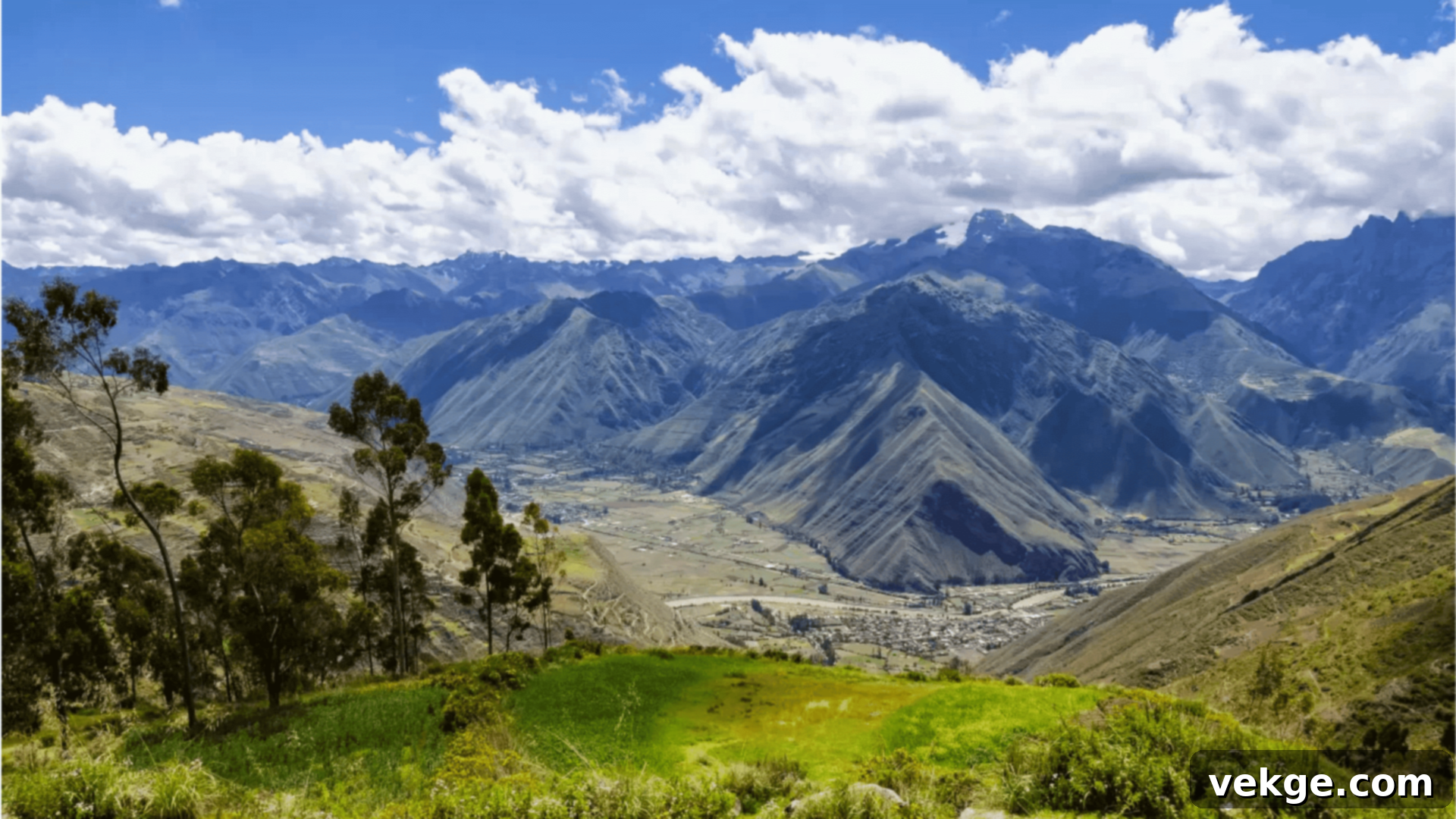
Overview: The Peruvian Andes form a spectacular and diverse mountain range that spans the entire length of Peru, creating a dramatic backbone to the country. This colossal mountain system is characterized by its towering snow-capped peaks, deep valleys, high-altitude plateaus (altiplano), and an incredible array of climates and ecosystems, making it a global hotspot for adventure and natural beauty.
Facts:
- It is known for its majestic snow-capped peaks, including Huascarán (Peru’s highest), and some of the most dramatic mountain landscapes in the world.
- Offers unparalleled opportunities for hiking, trekking, mountaineering, and enjoying stunning scenic views that attract adventurers globally.
- The Andes are home to numerous indigenous communities, preserving ancient traditions and languages like Quechua and Aymara.
- The Cordillera Blanca, a range within the Peruvian Andes, boasts more than 50 peaks above 5,700 meters (18,700 feet).
Why Visit: The Peruvian Andes are an outdoor paradise for adventure seekers and nature enthusiasts. From challenging multi-day treks like the Santa Cruz trek to gentler day hikes and scenic drives, there are countless ways to experience its raw beauty. Discover remote villages, marvel at glacial lakes, and immerse yourself in the awe-inspiring grandeur of one of the world’s greatest mountain ranges.
Interesting Fact: The Andes are home to a diverse range of climates and ecosystems, varying dramatically with altitude. This vertical zonation supports a vast array of flora and fauna, from high-altitude camelids like llamas and alpacas to diverse bird species, making it a critical biodiversity zone and a unique natural laboratory.
35. Qorikancha: The Golden Temple of the Incas
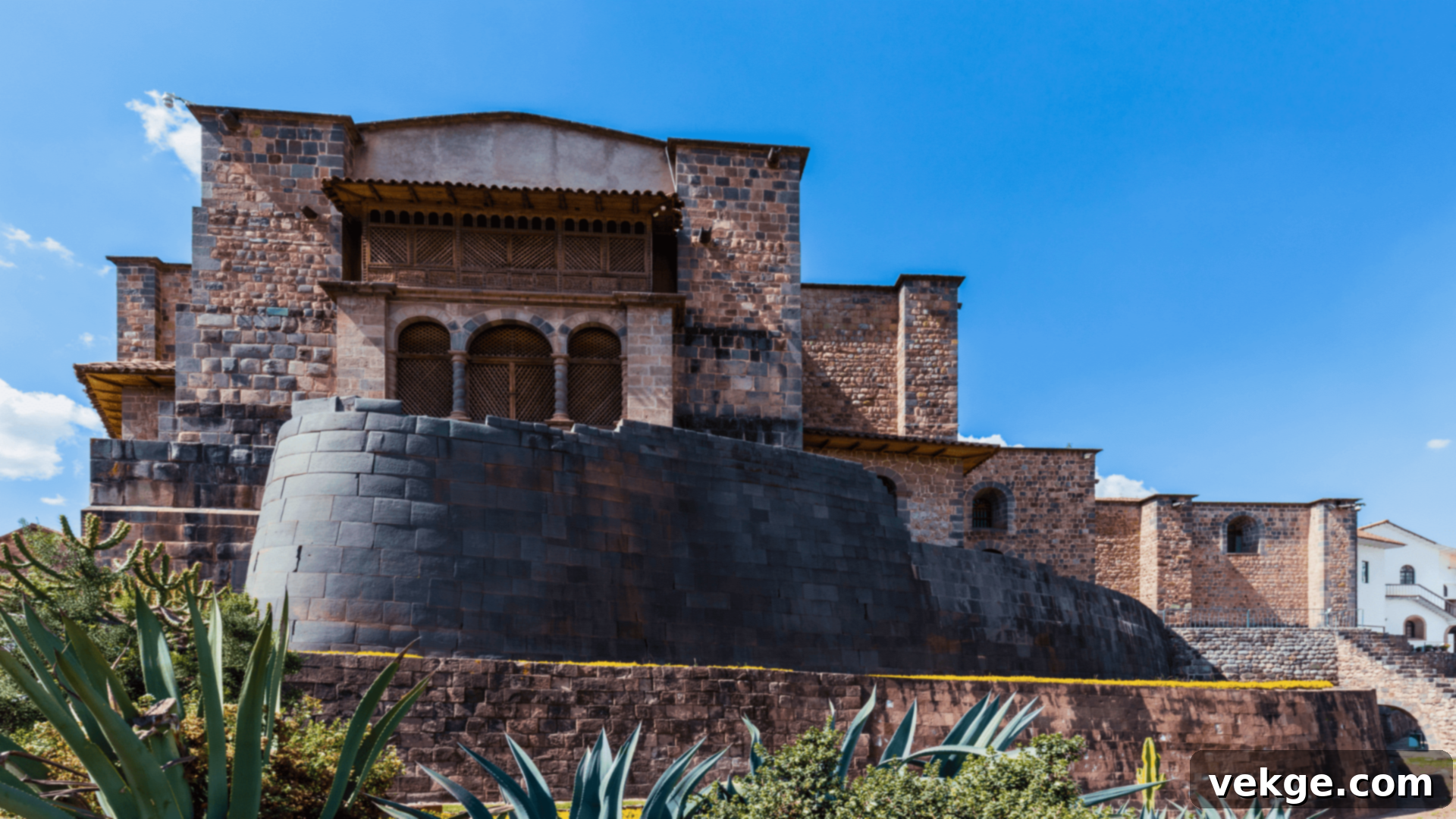
Overview: Qorikancha, meaning “Golden Courtyard” in Quechua, was the most sacred and opulent Inca temple in Cuzco, dedicated primarily to Inti, the Sun god, but also housing shrines for other deities like the Moon, stars, and thunder. After the Spanish conquest, the Santo Domingo Church and convent were built directly on its formidable Inca foundations, creating a striking fusion of two distinct architectural styles.
Facts:
- It was famously known for its golden walls, which were once entirely covered in sheets of pure gold, symbolizing the Inca’s reverence for the Sun.
- Today, the site is part of the Santo Domingo Church and Convent, where the meticulously crafted Inca stonework is visible beneath and within the colonial structure.
- The Inca masonry here is among the finest in Cuzco, demonstrating incredible precision and earthquake-resistant design.
- Qorikancha also served as an astronomical observatory.
Why Visit: Qorikancha offers a captivating glimpse into the grandeur and spiritual life of the Inca Empire, juxtaposed with the arrival of Spanish colonialism. Explore the impressive Inca stonework, which remains perfectly preserved, and reflect on the history embedded within its walls. The museum on site provides further context, making it an essential visit to understand Cuzco’s layered past.
Interesting Fact: Qorikancha was undoubtedly the richest temple in the entire Inca Empire, a testament to the Incas’ advanced metalworking skills and their profound devotion to the Sun god. The vast quantities of gold and silver that adorned its walls were later plundered by the Spanish conquistadors, melted down for their own use.
36. Titicaca Islands (Uros and Taquile): Living Traditions
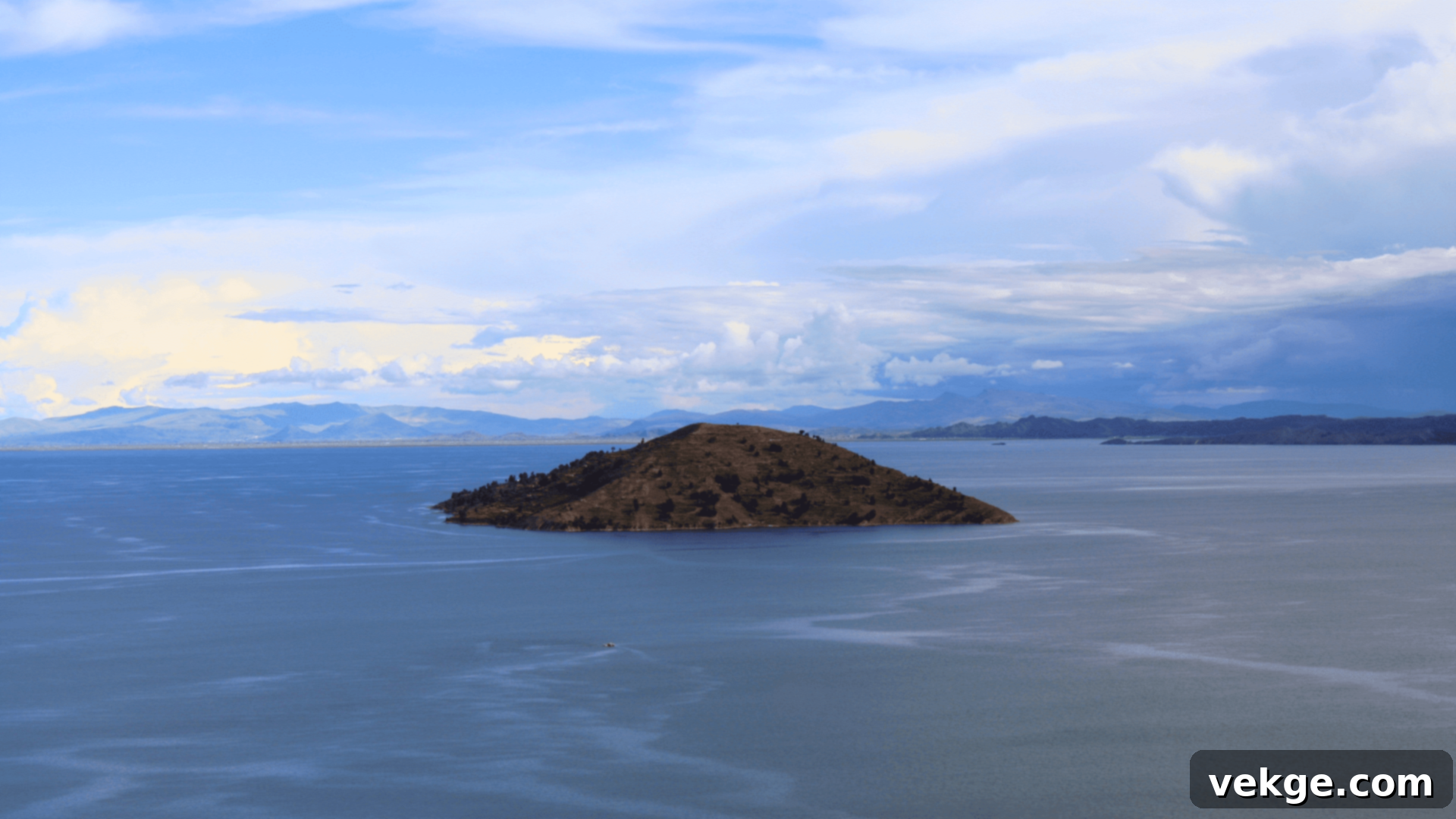
Overview: The islands of Lake Titicaca, particularly the Uros Floating Islands and Taquile Island, offer a unique and profound cultural experience. The Uros people live on incredible man-made floating islands constructed entirely from totora reeds, while Taquile is renowned for its vibrant indigenous community, distinct traditional clothing, and intricate weaving techniques, providing a window into ancient Andean customs.
Facts:
- The Uros Floating Islands are artificial islands crafted from layers of buoyant totora reeds, which the Uros people constantly replenish.
- Taquile Island is a UNESCO Masterpiece of the Oral and Intangible Heritage of Humanity, specifically for its unique textiles and weaving techniques, where knitting is a male tradition.
- Both islands offer incredible cultural experiences, allowing visitors to interact with local communities and learn about their traditional lifestyles.
- The panoramic views of Lake Titicaca from these islands are simply breathtaking.
Why Visit: A visit to the Titicaca Islands is a journey into living ancient traditions and stunning natural beauty. Experience the fascinating ingenuity of the Uros people as they maintain their reed islands, and immerse yourself in the vibrant culture of Taquile, where community life and textile arts thrive. It’s an opportunity to connect with indigenous communities, learn about their unique heritage, and appreciate the serene landscapes of the highest navigable lake in the world.
Interesting Fact: The Uros people have lived on these remarkable floating islands for thousands of years, originally as a defensive strategy against more aggressive tribes. Their entire way of life revolves around the totora reed, which they use not only for their islands and homes but also for boats, fuel, and even food.
How to Make the Most of Your Peruvian Adventure
To truly immerse yourself in the wonders of Peru’s incredible landmarks, preparation is key. Here are some essential tips to help you make the most of your visit:
- Comfortable Footwear: Many sites, especially Machu Picchu and the various archaeological ruins, involve extensive walking, stair climbing, and uneven terrain. Comfortable, sturdy walking shoes are indispensable.
- Stay Hydrated: High altitudes and varying climates mean it’s crucial to drink plenty of water throughout your trip. Always carry a reusable water bottle.
- Sun Protection: The sun in Peru, especially at high altitudes or near the coast, can be intense. Don’t forget high-SPF sunscreen, a wide-brimmed hat, and sunglasses to protect yourself.
- Book in Advance: For popular attractions like Machu Picchu and the Inca Trail, tickets and permits are limited and sell out quickly. Book your entry tickets, train tickets, and guided tours well in advance, sometimes several months ahead.
- Acclimatization: If you’re visiting high-altitude areas like Cuzco or Lake Titicaca, allow at least 1-2 days to acclimatize before attempting strenuous activities. Drink coca tea and stay hydrated to help prevent altitude sickness.
- Learn the History: Take some time to research the historical and cultural significance of the places you visit. This will deepen your appreciation and provide a richer context for the incredible sites you encounter.
- Consider a Guide: Hiring a local, certified guide can significantly enhance your visit, offering invaluable insights into the history, culture, and natural environment of the landmarks. They can provide stories and details you might otherwise miss.
- Respect Local Culture: Peru has a rich and vibrant indigenous culture. Be respectful of local customs, ask permission before taking photos of people, and support local communities by purchasing from artisans.
- Carry Cash: While cards are accepted in major cities, having small denominations of Peruvian Soles (PEN) is useful for local markets, smaller vendors, and tips.
Conclusion: Peru – A Journey Through History and Nature
Peru is truly a land of unparalleled beauty, profound history, and vibrant living culture, boasting some of the most beautiful and historically significant landmarks in the world. From the majestic, cloud-shrouded citadel of Machu Picchu to the enigmatic Nazca Lines etched into the desert floor, and from the breathtaking depths of Colca Canyon to the bustling heart of its ancient capital, Cuzco, each site vividly showcases the country’s rich heritage and astonishing natural diversity.
Whether your passion lies in ancient civilizations, thrilling outdoor adventures, deep cultural immersion, or simply breathtaking natural landscapes, Peru offers an extraordinary array of experiences that cater to every traveler’s dream. Visiting these iconic landmarks provides a unique and unforgettable opportunity to connect with the legacies of powerful empires, witness incredible engineering feats, and explore some of the most biodiverse ecosystems on Earth.
Embarking on a journey through Peru’s landmarks will not only provide you with a deeper understanding of its past and present but also create cherished memories that will last a lifetime. These sites offer a unique and profound look at the soul of Peru, making them an absolute must-see for anyone traveling to this captivating South American nation.
For more travel ideas, detailed guides, and tips on other incredible places to explore, be sure to check out our other blogs and resources on the website for similar content. Plan your next adventure today!
Happy travels!
